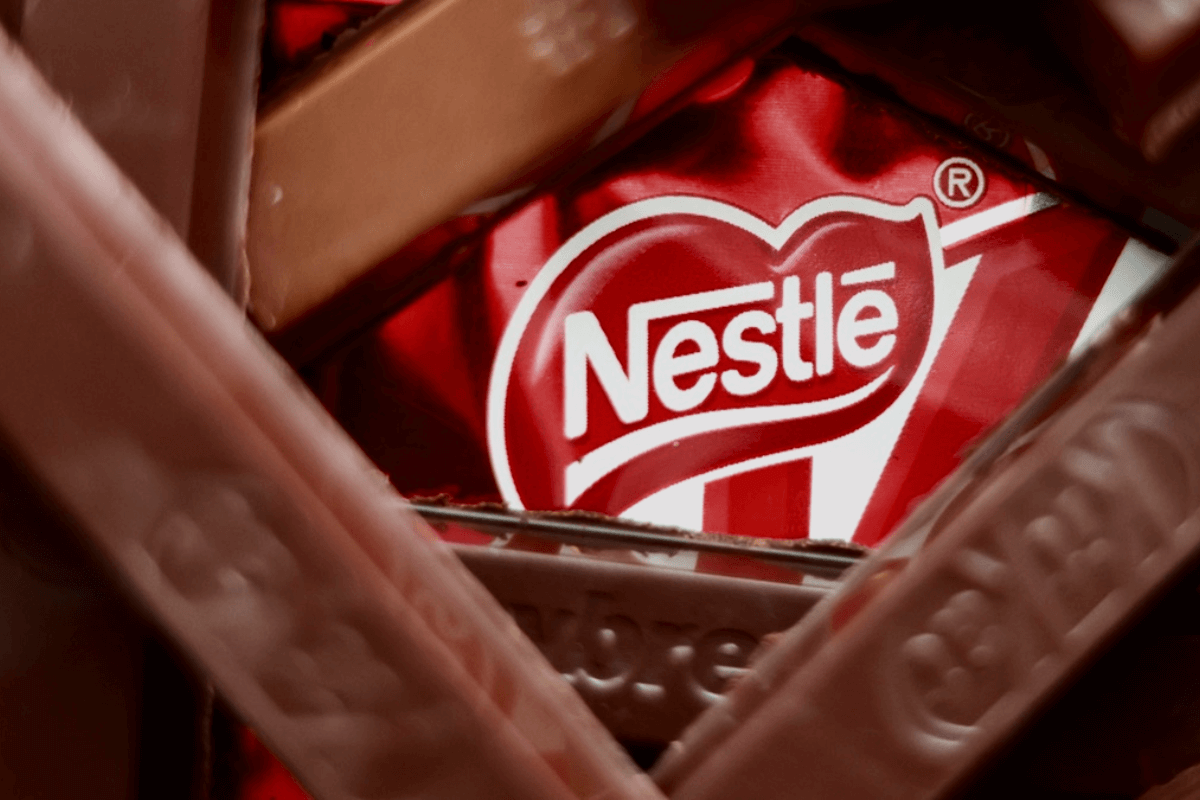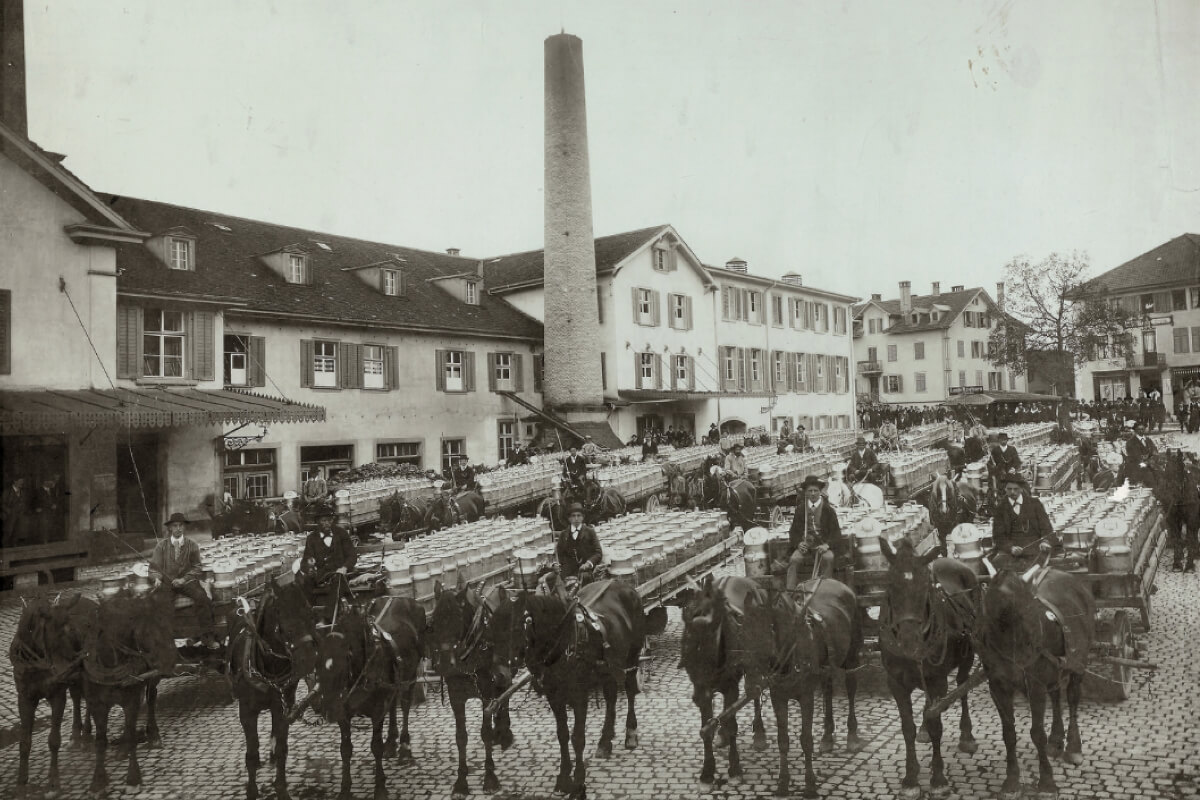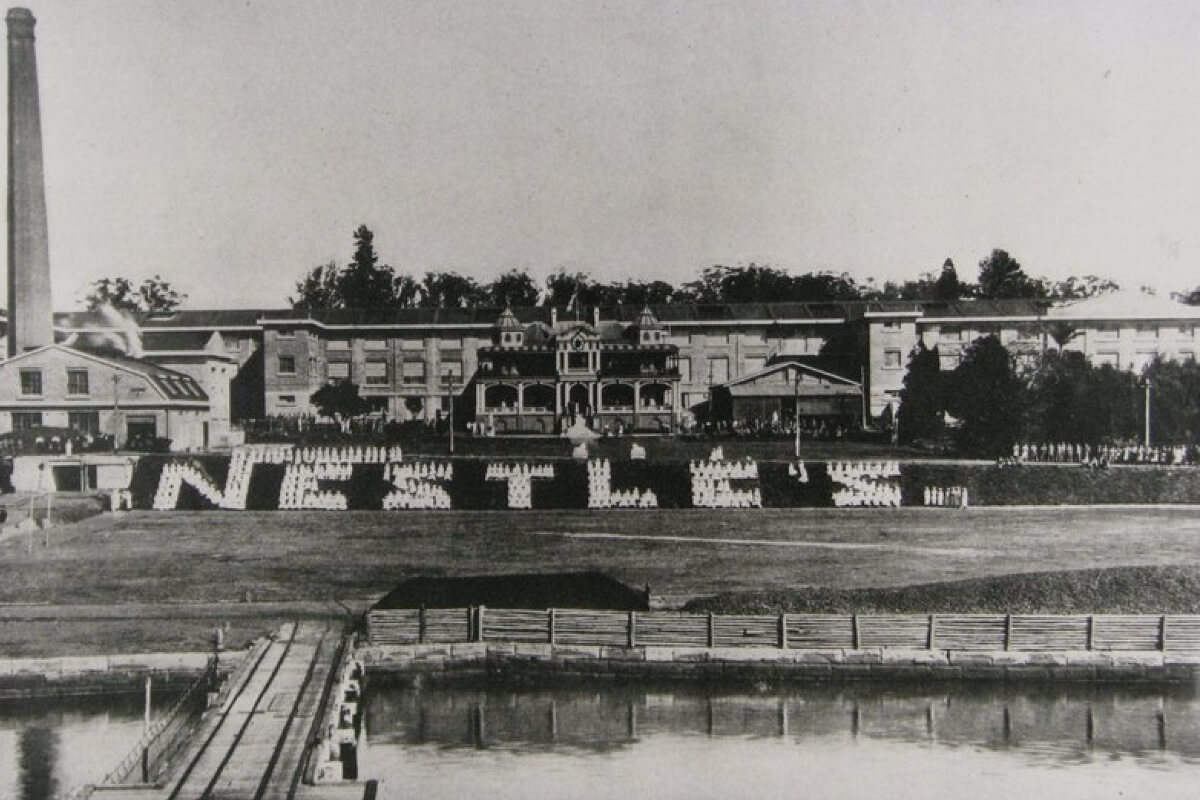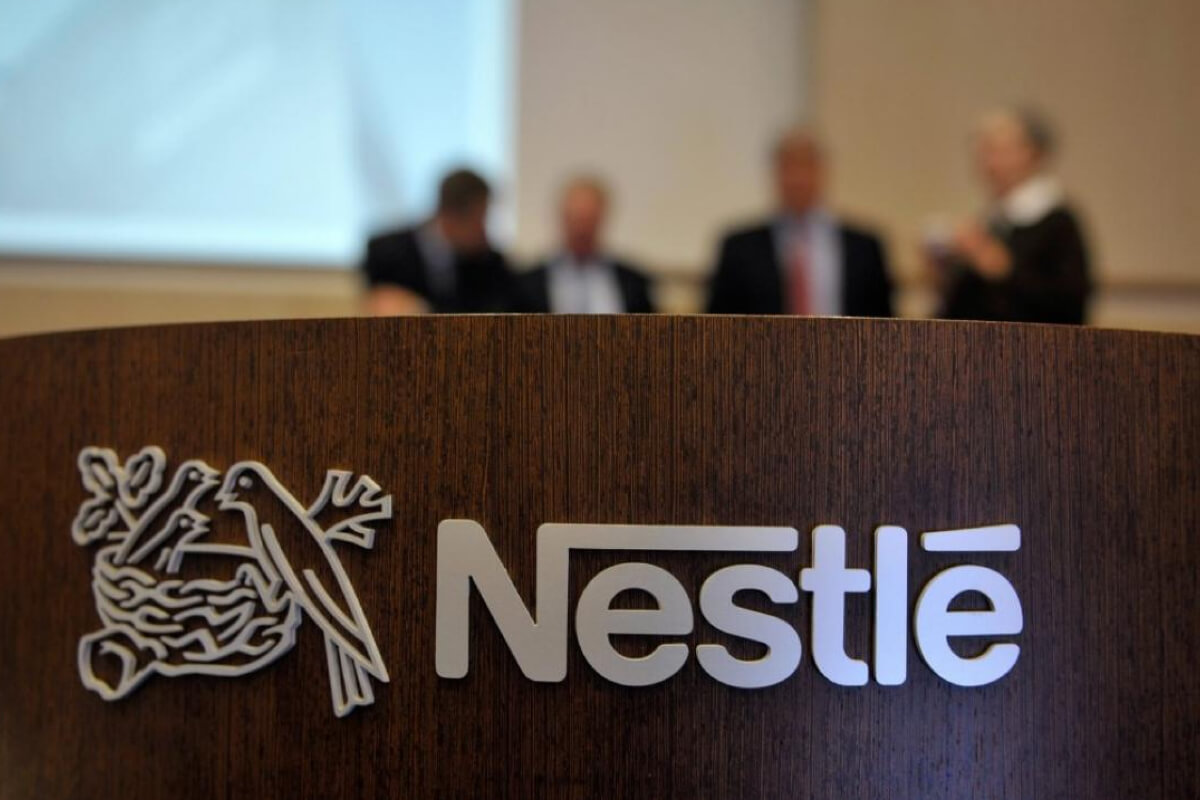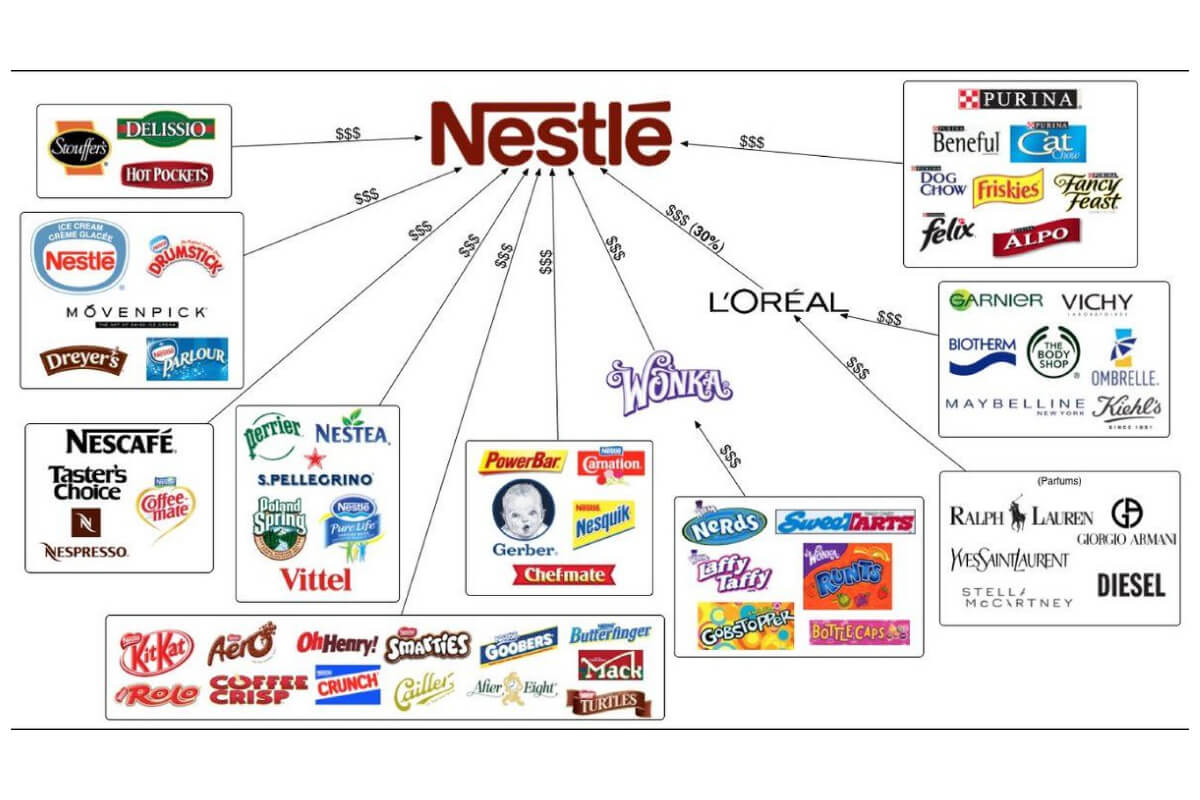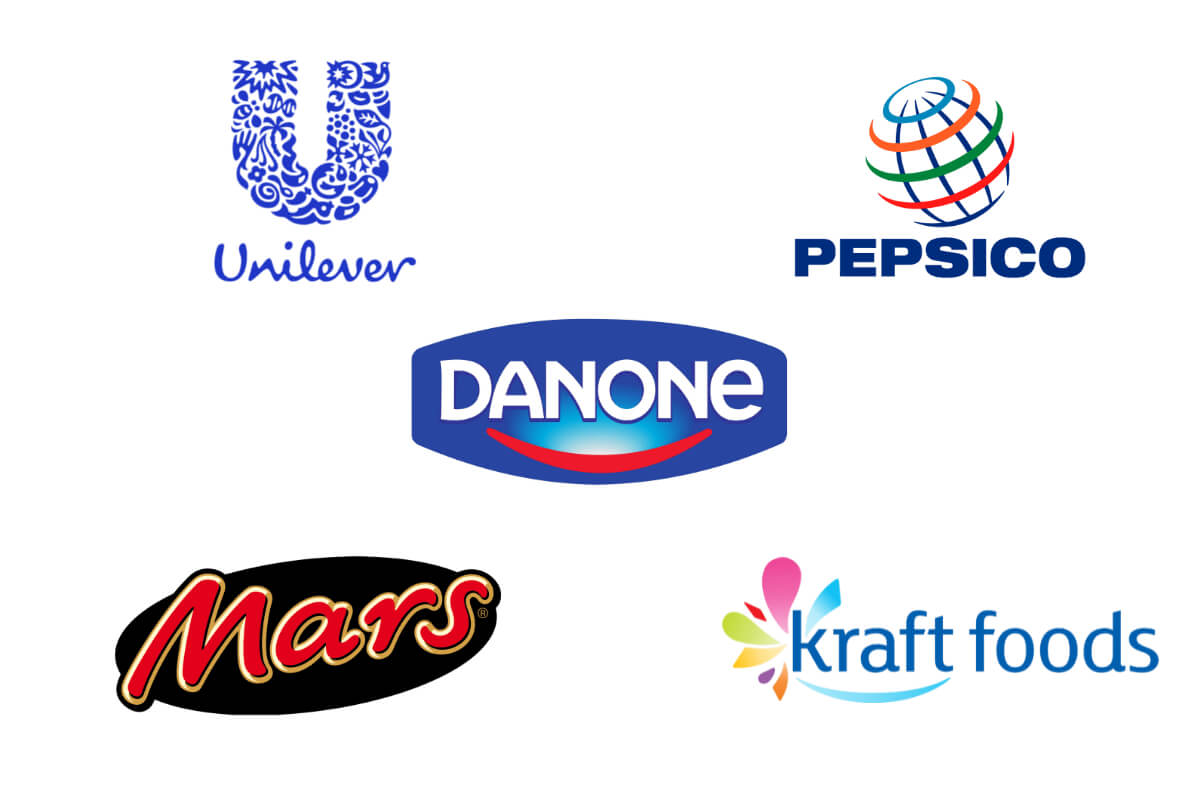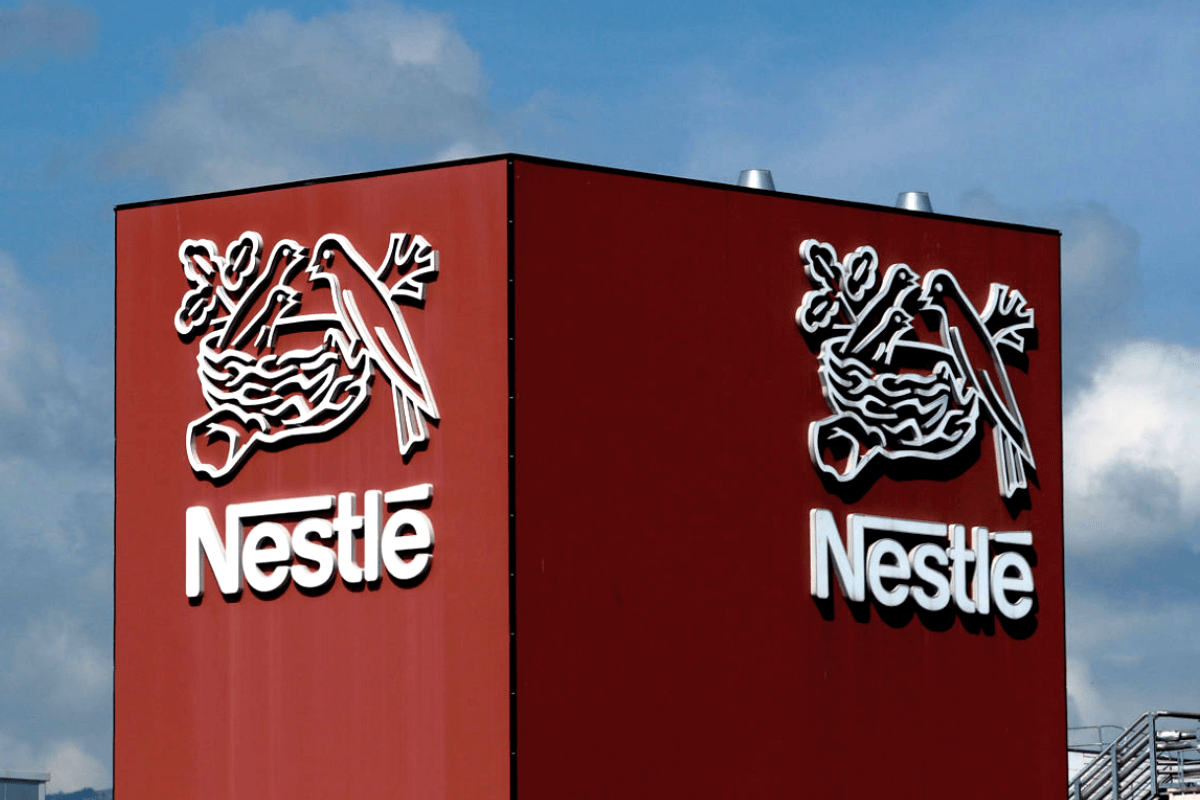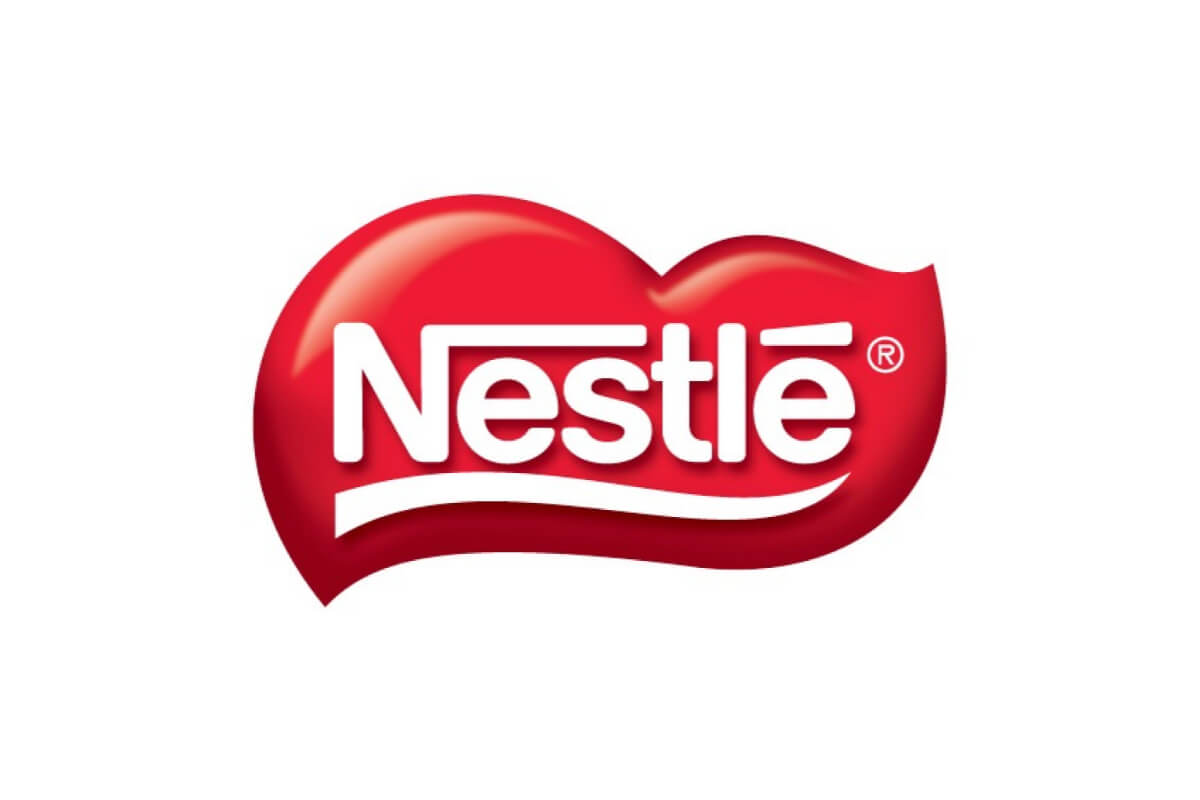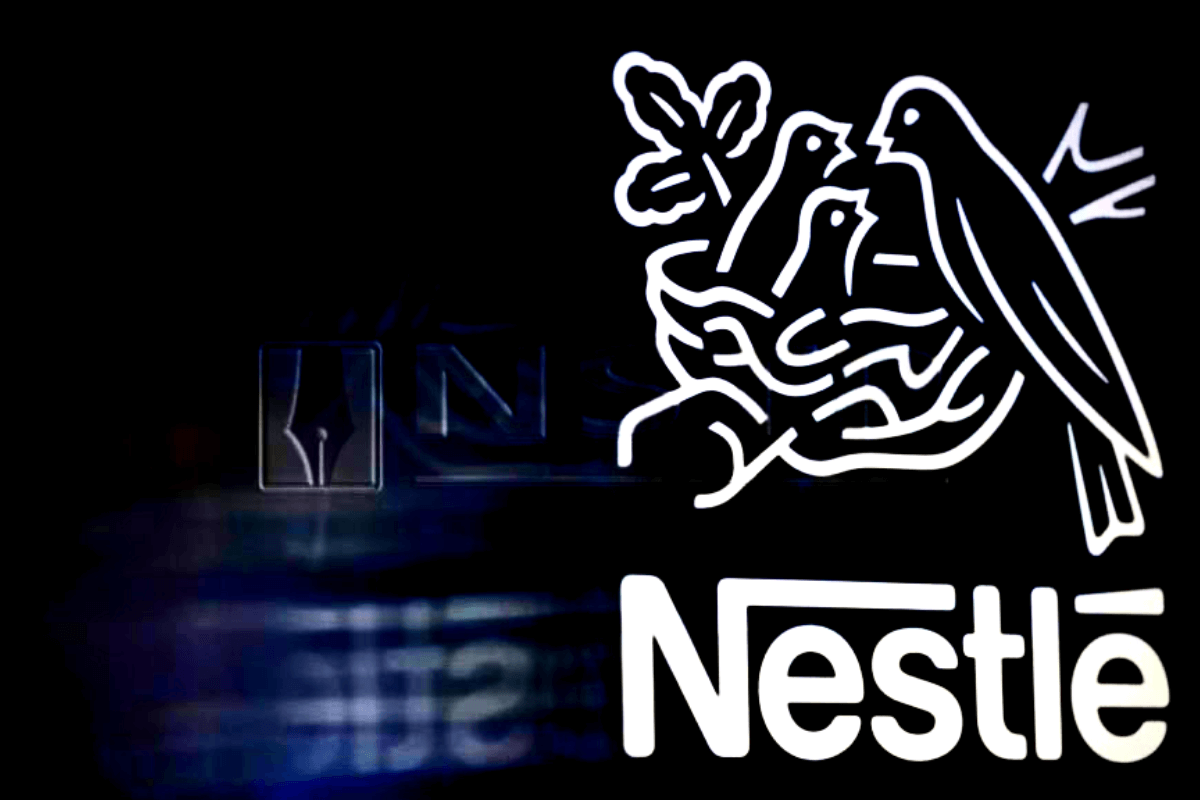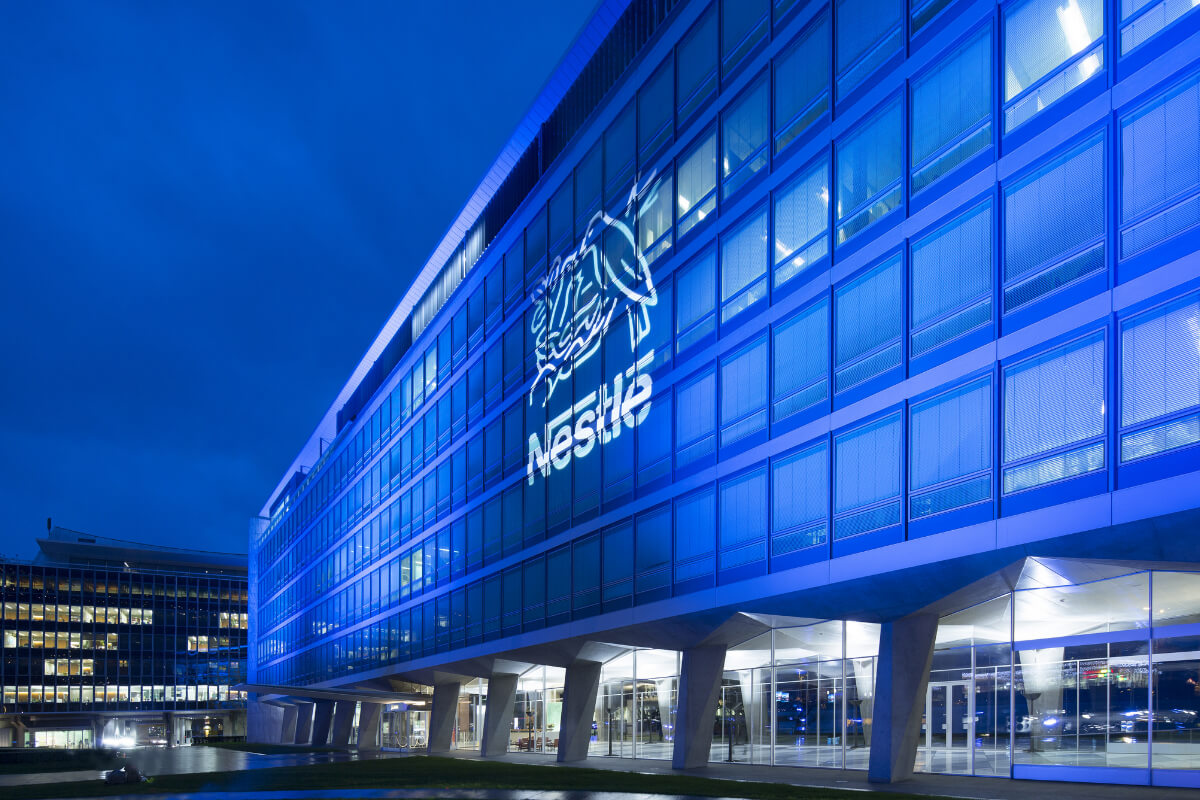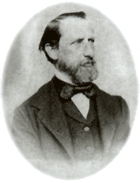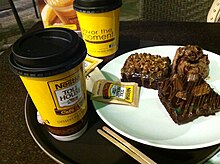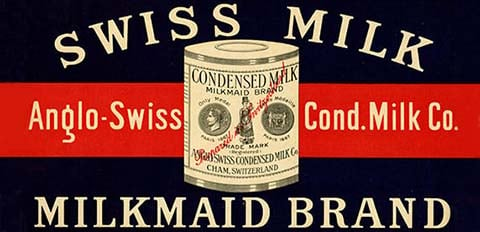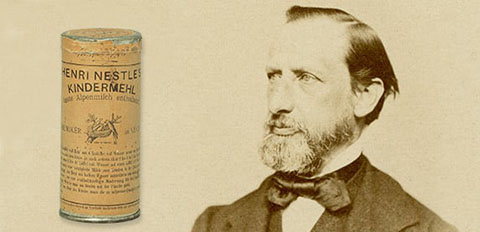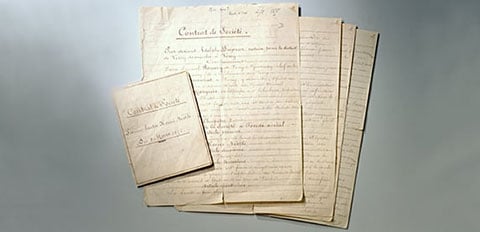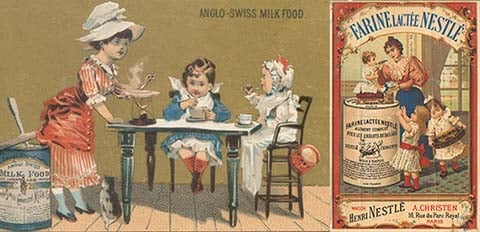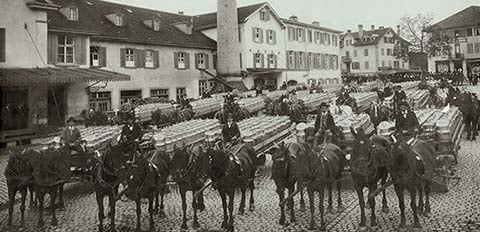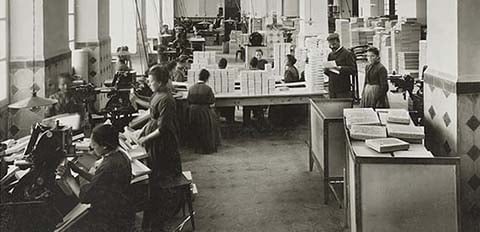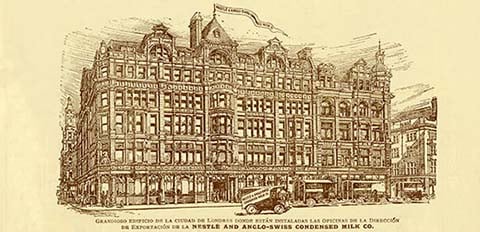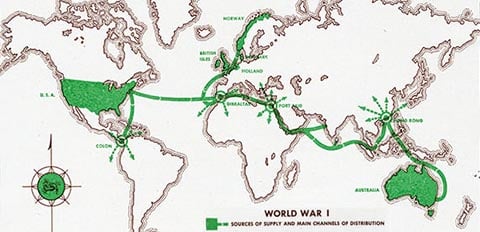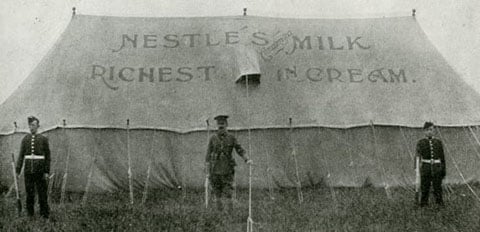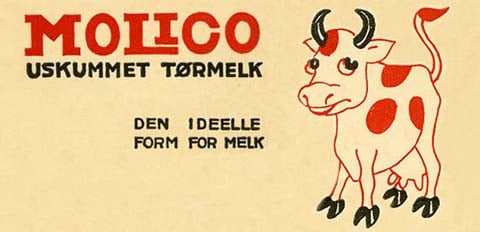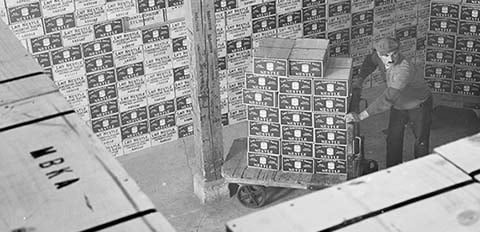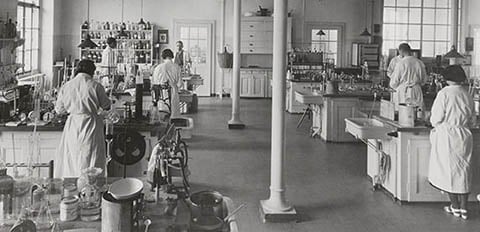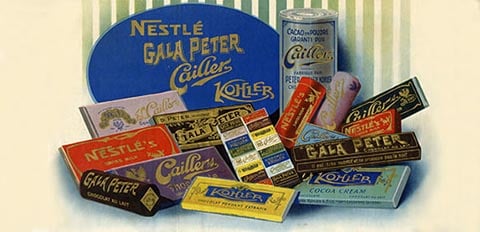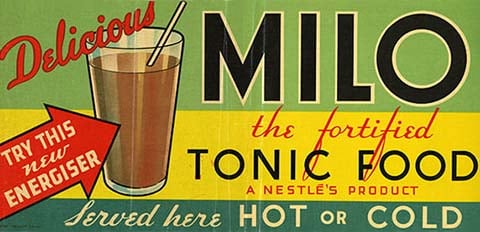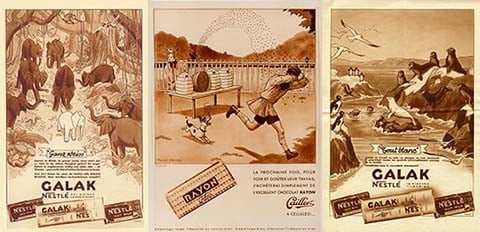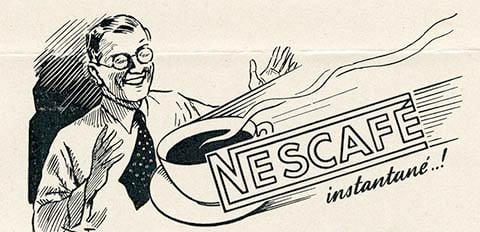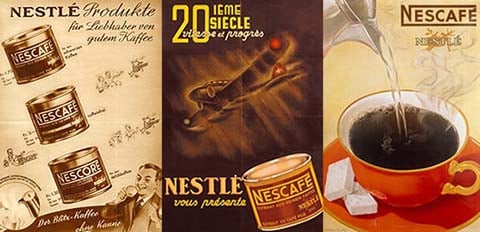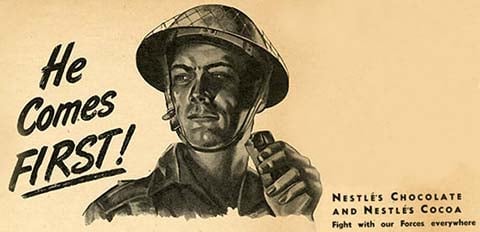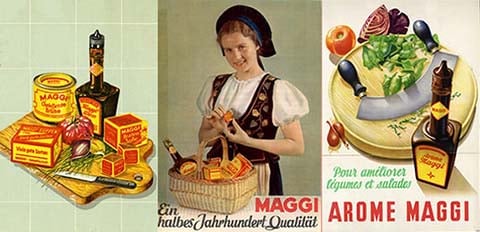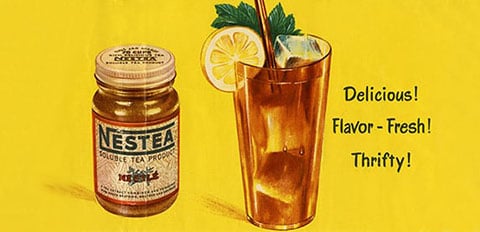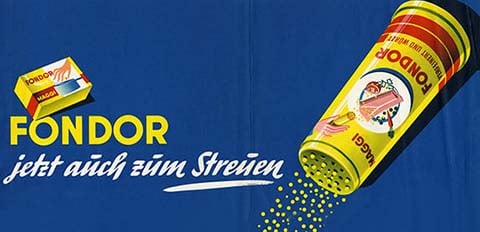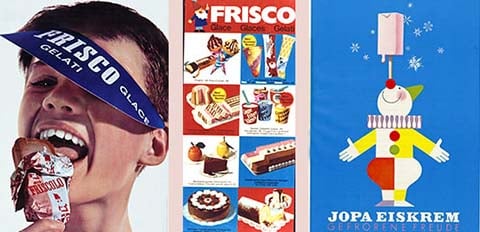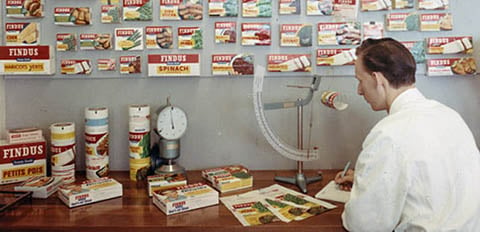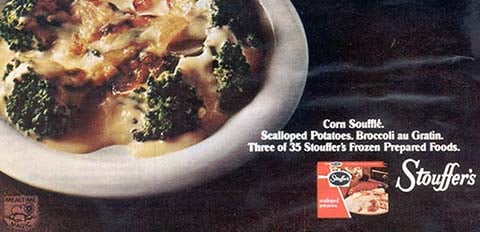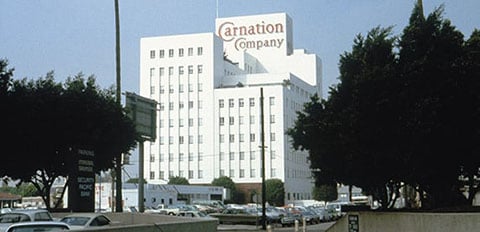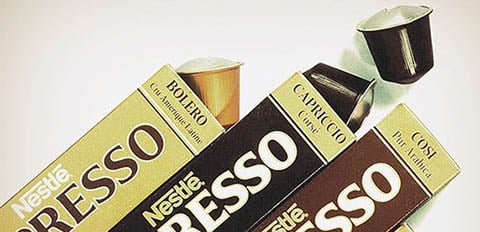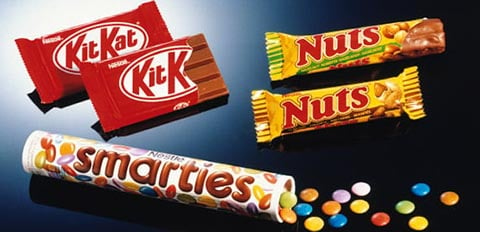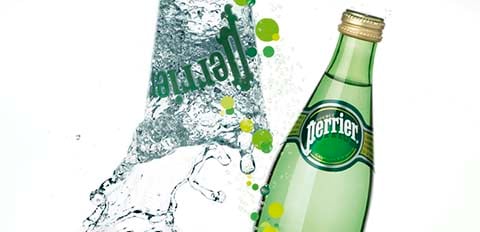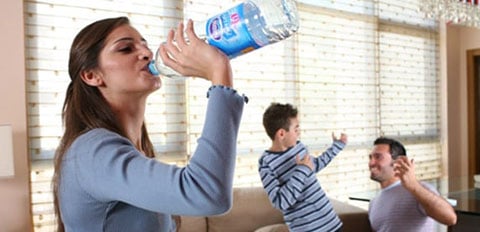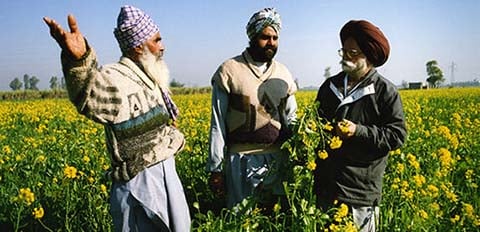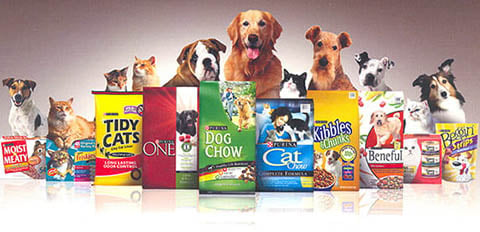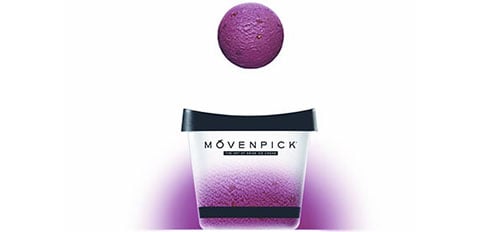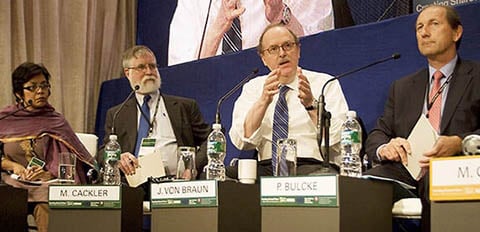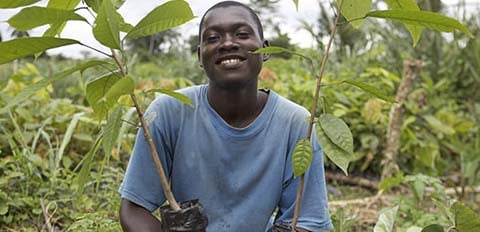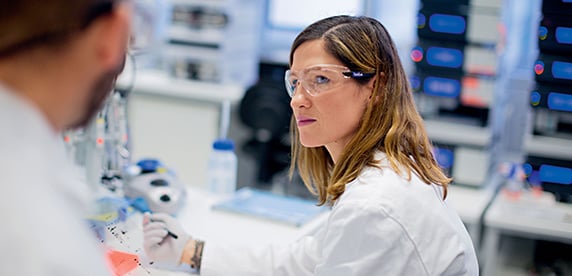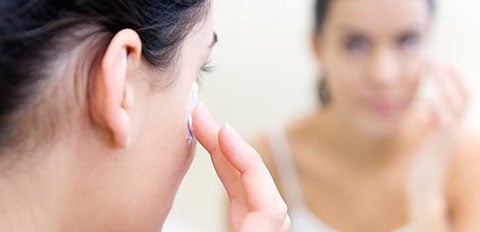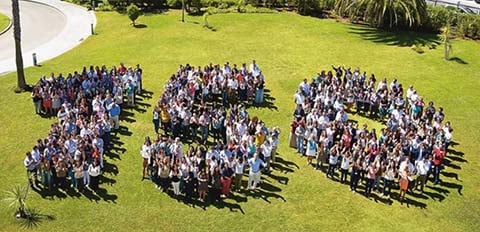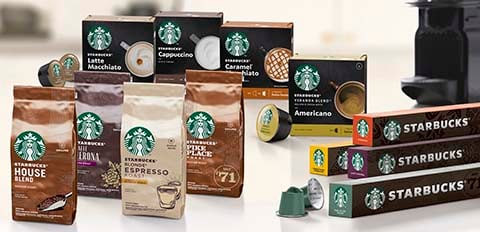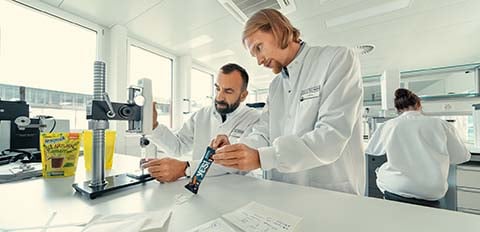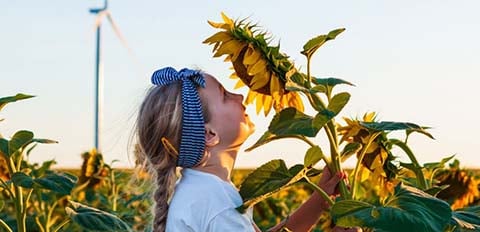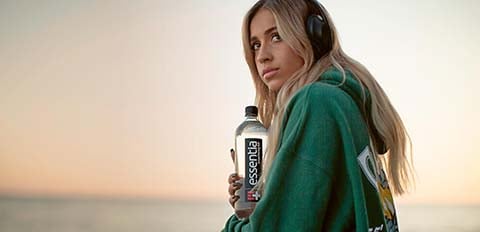
- Home
- О компании
- История компании
История компании
Полная история появления и развития компании Нестле. Узнайте подробно в чем секрет успеха Nestle. Интересные факты и достижения
Вкусные завтраки «Несквик», шоколадки «КитКат», растворимый Кофе «Нескафе», бульонные кубики «Магги», мороженое «Максибон», капсулы для кофемашин «Неспрессо», минеральная вода «Виттель», холодный чай «Нести», корма для питомцев «Пурина» и «ПроПлан». Все это — великий и могучий концерн Nestlé, который за полуторавековую историю успел объединить под своим началом более 2000 производителей продуктов питания. Команда Бизнес-журнала lindeal.com предлагает вам проследить, как маленькая компания немецкого фармацевта Анри Нестле превратилась за 150 лет в настоящего гиганта, крупнейшего производителя продовольствия на планете.
Nestlé: что это такое? (краткая справка о компании)
Nestlé Société Anonyme — швейцарская транснациональная корпорация, крупнейший в мире производитель продуктов питания:
- Дата основания: 1866.
- Основатели: Анри Нестле, Джордж и Чарльз Пейдж.
- Руководители: председатель совета директоров Пол Бюльке, СЕО Ульф Марк Шнайдер.
- Число сотрудников: 276 000.
- Дочерние предприятия: Nestea, Vittel, Bonka, Nestle Waters, Alcon, Nestle (United States, Canada, Rossiya, España, India), Orion, Осем, Froneri, Nestlé Česko, BlueTriton Brands, Nespresso, Nestlé Deutschland, Hjem-IS, Deutsche Aktiengesellschaft für Nestle-Erzeugnisse, Rowntree’s.
Акционерная компания «Нестле» известна своими брендами «КитКат», «Магги», «Несквик», «Нескафе», «Нести». В настоящее время производит детское и лечебное питание, молочную продукцию, растворимый кофе, специи и бульоны, мороженое и шоколад, холодный чай и минеральную воду, косметику и фармацевтическую продукцию, замороженные блюда и готовые завтраки, а также корма для домашних животных.
Летопись «Нестле» с 1866 года по сегодняшний день
История современного продуктового гиганта Nestlé началась в 1866 в Швейцарии, в местечке Шам: в тот год «Англо-Швейцарская компания» запустила первую в Старом Свете фабрику по производству сгущенного молока. Ее основатели, братья-американцы Джордж и Чарльз Пейдж, использовали собственный опыт, накопленный в Штатах. Европейская горная страна, славящаяся своим альпийским молоком, стала идеальным местом для производства. Наладив процесс, предприниматели начали поставлять свою продукцию в крупные города Европы под брендом Milkmaid — вкусная, безвредная и долго хранящаяся альтернатива обычному молоку.
1866-1905: создаем свои ценности
Уже год спустя после открытия события стали быстро развиваться:
- 1867: германский фармацевт Анри Нестле основал свою фабрику — налаживает Производство «молочной муки» Farine Lactée в швейцарском городе Веве. Ученый обратился к разработке смеси из коровьего молока, сахара и пшеничной муки, чтобы снизить смертность среди малышей, которые не могли быть вскормлены натуральным грудным молоком. Именно тогда разработчик начал впервые использовать знакомый нам логотип с птенцами и гнездом.
- 1875: Анри продает свою фабрику профессиональным бизнесменам, способным качественно увеличить объемы производства и продаж.
- 1878: начало ожесточенной конкуренцией между «Англо-Швейцарской компанией» и «Нестле», поставляющими на рынок аналогичные продукты — детские смеси и сгущенку.
- 1904: купив право на Экспорт продуктовых изделий Peter & Kohler, Nestlé запускает торговлю шоколадом. В это же время Анри Нестле разрабатывает авторский рецепт молочного шоколада, который совсем скоро оценивается как коммерчески успешный продукт.
В 1905 предприятие Анри Нестле объединилось с «Англо-Швейцарской Компанией», чтобы образовать совместный концерн. И тому было самое время: городское население увеличивается, пароходное и железнодорожное сообщение усиленно развивается, что позволило снизить цены на товары широкого потребления и открыть новые возможности для транснациональной торговли.
1905-1913: вступаем в прекрасную эпоху
Объединенное предприятие «Нестле», обладая 20 продуктовыми фабриками, начинает расширение в Азию, Австралию, Африку и Южную Америку посредством зарубежных дочерних предприятий. Это позволяет концерну до начала Первой Мировой войны удерживать статус крупнейшего мирового производителя молочных продуктов. Nestlé & Anglo-Swiss Milk Company располагало двумя штаб-квартирами, в Шаме и Веве, к которым вскорости присоединился третий центральный офис — в Лондоне. Целью английского отделения было увеличение экспортных поставок. Параллельно расширяется ассортимент бренда, который уже включает сгущенку без содержания сахара и стерилизованное молоко.
1914-1918: сквозь тяжкие годы Первой Мировой
С началом военных действий спрос на шоколадные изделия и сгущенное молоко существенно возрос, однако нехватка необходимого сырья, ограничения на международные торговые операции негативно сказались на производственных масштабах Nestlé & Anglo-Swiss.
- 1914: в связи с началом войны «Нестле» получает государственные заказы на свою продукцию.
- 1915: консервированное сгущенное молоко Nestlé включено в «неприкосновенный запас продовольствия» для солдат британской армии, что ведет за собой бешеный спрос на продукт.
- 1916: приобретение норвежской торговой фабрики Ergon, обладательницы патента на оригинальное производство молочного порошка.
Чтобы решить проблему с дефицитом производства, торговая марка активно скупает производственные объекты в Австралии и Соединенных Штатах — так, к концу войны на «Нестле» работает уже 40 фабрик.
1919-1938: от кризиса — к новым возможностям
После завершения Первой Мировой спрос на консервированное молоко резко падает, что приводит в 1921 к серьезному кризису и убыткам в объединенной компании. Только-только «Нестле» удается оправиться, как новая сложная проблема — катастрофическое падение курса акций на Нью-Йоркской Бирже (1929).
- 1929: приобретение крупнейшего швейцарского производителя шоколада Peter-Cailler-Kohler, создавшего первый в стране шоколадный бренд «Кейлер».
- 1934: выпуск для австралийских покупателей солодово-шоколадного напитка Milo.
- 1934: начало производства цельномолочного порошка для грудных детей Pelargon, обогащенного кисломолочными бактериями для лучшего усвоения.
- 1936: презентация интересной новинки — белого шоколада Galak.
- 1936: ввиду увлечения мирового сообщества витаминами, «Нестле» производит собственные витаминные добавки Nestrovit.
- 1937: свежая новинка — пористая шоколадка с медовой начинкой Rayon.
- 1938: запуск одного из самых популярных продуктов компании — растворимого кофе Nescafé. Чтобы насладиться натуральным кофейным вкусом, нужно было лишь разбавить порошок горячей водой — просто настоящая диковинка для своего времени! «Нескафе» стал результатом 9-летней кропотливой работы химика Макса Моргенталера.
Но вместе с проблемами появились и новые достижения, путь возможностей: повышение профессионализма руководящего звена, централизация научной и исследовательской работы, выход новых продуктов, полюбившихся потребителям, — среди них был и кофе «Нескафе».
1939-1947: «под натиском бури»
Несмотря на то, что события Второй Мировой войны больно ударили по всем мировым производителям, «Нестле» удалось «выдержать натиск бури» — исправно снабжать своей продукцией как армию, так и гражданское население.
- 1939: опасаясь оккупации Швейцарии, бренд перебрасывает основные силы в новый штаб-офис в Стэмфорде (Соединенные Штаты). Параллельно увеличивается производство в Южной Америке, расширяются закупки сырья в Австралии и США для поставок в Африку и Азию.
- 1942-1945: продукты «Нестле» становятся популярными у американских военных, а в 1945 включаются в состав гуманитарной помощи, отправленной населению Японии и европейских стран.
- 1947: объединение со швейцарским производителем бульонов и приправ Alimentana, выпускающим свою продукцию под брендом Maggi. Название дано по имени Юлиуса Магги, разработавшего в 1884 формулу обогащенного протеином порошкового супа.
Именно в этот период концерн получил новый нейм Nestlé Alimentana и пополнил свой ассортимент специями и быстрыми супчиками «Магги».
1948-1959: все для вас!
Так как послевоенный период истории отличался постепенным ростом благосостояния населения, европейцы и американцы не скупились на удобную бытовую технику — холодильники и морозильные камеры. А значит, могли заинтересоваться замороженными продуктами — полуфабрикатами и блюдами быстрого приготовления.
- 1948: первый выпуск универсального быстрорастворимого напитка, чая Nestea, который оставался бодрящим и вкусным как в горячем, так и в охлажденном виде.
- 1948: презентация на американском рынке быстрорастворимого какао Nesquik, которое можно было с успехом развести даже в холодном молоке! Неудивительно, что новинка выбилась в лидеры продаж.
- 1948: еще одним популярным продуктом стала детская каша быстрого приготовления, которая в 1954 претерпела ребрендинг и предстала уже под известным нам названием Cerelac.
- 1954: открыли производство универсальной порошковой приправы Fondor в удобной практичной баночке с отверстиями — специю можно было применять как для готовых блюд, так и в кулинарном процессе.
- 1957: выпуск качественно нового для рынка продукта — консервированных равиоли «Магги». Они были с таким восторгом приняты публикой, что «Нестле» занялась расширенной разработкой и запуском консервированных обедов быстрого приготовления.
Эпоха пятидесятых-шестидесятых — «золотое время» для готовых напитков и блюд по типу «Магги» или «Несквик».
1960-1980: время расти и расширяться
На этом периоде развития корпорация активно практикует слияния, приобретает новые активы в самых перспективных и динамично развивающихся сегментах продуктового рынка. Вместе с расширением ассортимента кофейной, консервированной, молочной и замороженной продукции, компания выходит в совершенно новые для себя сферы — косметическую и лекарственную.
- 1960: воспользовавшись повсеместно увеличивающимся спросом на мороженое (связанным с широким распространением холодильников) «Нестле» покупает сразу двух производителей ледяного лакомства — Jopa (Германия) и Heudebert-Gervais (Франция).
- 1960: покупка производителя замороженных блюд Crosse & Blackwell.
- 1962: приобретение еще одной фабрики мороженого, Frisco (Швейцария).
- 1962: покупка торговой марки замороженных продуктов Findus (бывший владелец — шведская компания Marabou), которая с 1945 являлась одной из самых успешных в своей отрасли.
- 1968: «Нестле» ловит новую глобальную моду на увлечение молочными охлажденными продуктами. Концерн приобретает производителя йогуртов Chambourcy (Франция).
- 1969: расширение в сферу минеральной воды приобретением доли в капитале Vittel (Франция).
- 1970: запуск новой йогуртной линейки Sveltesse специально для тех, кто заботился о фигуре и правильном питании.
- 1973: приобретение американского производителя замороженных продуктов Stouffer Corporation.
- 1974: «Нестле» становится «миноритарным акционером» крупнейшего глобального изготовителя косметических средств и парфюмерии L’Oréal.
- 1976: покупка бизнеса по производству консервов Libby, McNeill & Libby.
- 1977: приобретение производителя медикаментозных средств и офтальмологической продукции Alcon Laboratories.
- 1977: концерн получает новый нейм Nestlé S.A.
Тогда же, в 1960-1980-х, начинаются первые скандалы, связанные с детским питанием «Нестле». Концерн в ответ гарантирует «соответствие своей деятельности требованиям Кодекса Всемирной организации здравоохранения (ВОЗ) по маркетингу заменителей грудного молока».
1981-2005: уверенный рост и высокие результаты
Корпорация ставит перед собой амбициозную цель: «Стать лидером в производстве пищевых продуктов и экспертом в области правильного питания и здорового образа жизни». Для этого «Нестле» избавляется от уже неприбыльных брендов и сосредотачивается на активном продвижении продукции для выбранной ЦА — потребителей, заботящихся о своем Здоровье.
- 1981: создание нового бренда здоровых замороженных блюд Stouffer’s Lean Cuisine, отличающихся низкой калорийностью.
- 1981: запуск совместно с «Л’Ореаль» совместного дерматологического предприятия Galderma.
- 1985: вложение $3 млрд в приобретение компании Carnation (США), что позволяет расширить свой ассортимент еще двумя яркими брендами — Carnation и Coffee-Mate.
- 1985: выход на новый для концерна рынок товаров для четвероногих — «Нестле» приобретает Friskies, уже пользующийся мировой популярностью.
- 1986: начало одного из самых успешных брендов — Nespresso. Отныне каждый покупатель мог сделать себе чашечку великолепного кофе не хуже, чем бариста.
- 1988: приобретение кондитерской фабрики Rowntree Mackintosh (Великобритания), пополнение ассортимента новыми сладостями — KitKat, After Eight и Smarties.
- 1988: покупка производителя лакомств, специй и пасты Buitoni-Perugina (Италия).
- 1991: совместно с General Mills компания Nestlé организует совместный проект Cereal Partners Worldwide, чья цель — производить и продвигать готовые быстрые завтраки в глобальном контексте.
- 1991: запуск партнерского (с Coca-Cola Company) предприятия Beverage Partners Worldwide, призванного разрабатывать, производить и продвигать сразу несколько брендов, включая чай «Нести».
- 1992: заключение сделки о покупке производителей минералки France’s Perrier Group, которые в 2002 будут переименованы в Nestlé Waters.
- 1998: приобретение бизнеса по производству минеральной воды San Pellegrino Group (Италия), что ведет за собой запуск в развивающихся государствах новой торговой марки питьевой воды Nestlé Pure Life.
- 2000: презентация в Европе питьевого бренда Aquarel.
- 2000: запуск Sustainable Agricultural Initiative Nestlé — инициативы по сельскому хозяйству «Нестле», направленной на дружественное и взаимовыгодное сотрудничество с местными фермерскими хозяйствами.
- 2001: приобретение американского производителя кормов для животных Ralston Purina для объединения его с Friskies — выходит новый бренд Nestlé Purina Petcare, ставший глобальным лидером в сегменте товаров для питомцев.
- 2002: вложение $2,6 млрд в приобретение производителя замороженных блюд Chef America (США).
- 2002-2003: покупка сразу нескольких изготовителей мороженого — Häagen-Dazs, Dreyer’s Grand Ice Cream, Mövenpick.
В данный период развития «Нестле» ощутимо расширяется в Восточной Европе, Америке, Азии и задается целью удержания лидерских позиций по продажам минералки, мороженого и кормов для питомцев.
2006-сейчас: новое время — новый бизнес
Сегодня «Нестле» работает по инновационной стратегии «Создаем общие ценности». В ее рамках принимает участие в программах Nestlé Cocoa Plan и Nescafé Plan, чья цель — разработать и обеспечить должное функционирование экологически безвредных технологий и устойчивых поставок какао-бобов и кофейных зерен.
- 2006: покупка поставщика быстрых завтраков Uncle Toby’s (Австралия).
- 2006: приобретение проекта по разработке и запуску продукции, направленной на контроль массы тела, Jenny Craig.
- 2007: покупка производителя лечебного питания Novartis Medical Nutrition, поставщика минералки Sources Minérales Henniez и фабрики детских смесей Gerber.
- 2010: Kraft Foods продает «Нестле» свое отделение по изготовлению замороженной пиццы.
- 2011: запуск собственных научных подразделений Nestlé Health Science и Nestlé Institute of Health Sciences, призванных разрабатывать на базе последних передовых достижений продукты питания Нового Тысячелетия, способствующие профилактике и терапии хронических болезней.
- 2012: приобретение производителя детского питания Wyeth (Pfizer) Nutrition за $11,9 млрд.
- 2013: приобретение поставщика лечебного питания Pam Lab (США).
- 2014: учреждение нового направления Nestlé Skin Health, для которого у партнера «Л’Ореаль» выкупается доля в совместной дерматологической фабрике Galderma.
- 2015: запуск линейки шоколада «супер-премиум категории» Cailler.
- 2017: расширение на рынке потребительского здравоохранения покупкой Atrium Innovations.
В наши дни Nestlé активно развивает три категории — замороженные продукты, смеси для младенцев, лечебное питание.
Все бренды «Нестле»: какие продукты производит концерн?
Nestle — крупнейший в мире производитель продуктов питания, который владеет более 2000 брендов! Вспомним самые известные:
- Какао и кофе: Nescafe, Bonka, Nespresso, Caro, Milo, Nesquik.
- Шоколад и кондитерские изделия: Nuts, KitKat, Aero, Cailler, Polo, Toll House, Turtles, Rolo, Merier, Sundy, Galak, Docello, Lanvin, «Россия», «Бон Пари», «Комильфо», «Золотая марка».
- Молочная продукция: Ideal, Carnation, Sveltesse, Dalky, Yoco, Flanby, Chambourcy.
- Полуфабрикаты: Delissio, Herta, Findus, Buitoni, Hot Pockets.
- Детское питание: Nan, Nutrition, Nido, Gerber, Nestogen.
- Готовые завтраки: Cheerios, Fitness, Kosmostars, Nesquik, Chocapic.
- Вода и напитки: Nestea, Contrex, Viladrau, Vittel, Aquarel.
- Мороженое: Maxibon, Movenpick, Extreme, Miko, Fab, Mega.
- Соусы и приправы: Maggi, Thomy, Solis.
- Консервы: Chef, Libby’s, Litoral.
- Клиническое питание: Peptamen, Modulen, Clinutren.
- Корма для животных: Purina, Darling, Friskies, Gourmet, Pro Plan, Alpo, Felix, Dog Show.
Также компания владеет 30 % акций «Л’Ореаль», включающего в себя бренды: Garnier, Vichy, Maybelline, The Body Shop и пр.
Сколько зарабатывает «Нестле», кто владеет компанией?
Представим самые свежие финансовые показатели корпорации:
- Рыночная капитализация (2022): 315,26 млрд CHF.
- Доходность: 87,47 млрд CHF.
- Чистая прибыль: 16,71 млрд CHF.
- Операционные затраты: 27,1 млрд CHF.
- Свободный денежный поток: 9,29 млрд CHF.
- Основные группы товаров: растворимые и жидкие напитки, молочная продукция, детские смеси, медицинское питание, кондитерские изделия, мороженое, полуфабрикаты, корм для животных.
- Основные регионы сбыта: США, Китай, Франция, Бразилия, Великобритания, Мексика, Германия, Филиппины, Канада, Италия, Япония, Россия, Испания, Австралия, Индия.
- Кто владеет компанией (крупнейшие акционеры): Food Products (Holdings) S.A., Nestlé S.A., Norges Bank, BlackRock, Inc., Third Point Management.
Акции компании на момент написания статьи (Июль 2022) торгуются по 114,38 CHF. Всего выпущено 3 млрд ценных бумаг стоимостью в 234 млрд долларов. У частных акционеров — ⅕, остальная доля — у институциональных инвесторов.
5 главных конкурентов Nestlé на современном рынке
Сегодня главными оппонентами «Нестле» являются:
- Unilever — британский производитель продуктов питания и бытовой химиии.
- PepsiCo — транснациональная корпорация, специализирующаяся на пищевой промышленности и безалкогольных напитках.
- Mars — американский изготовитель продуктов питания длительного хранения от шоколадок до кормов для питомцев.
- Kraft Foods — концерн по производству упакованных продуктов питания.
- Groupe Danone — французский производитель молочных и иных продуктов питания.
Однако Nestlé не стоит беспокоиться: ближайший конкурент «Юнилевер» отстает от нее в контексте прибыли в 1,5 раза.
7 секретов успеха от крупнейшего производителя продуктов питания
Как маленький заводик «молочный муки» превратился в многомиллиардный мировой бизнес? Маркетологи выделяют целых семь секретов успеха «Нестле»:
- Системное расширение рынков сбыта, которое не дает упираться в потолок продаж.
- Новаторский подход: «мы не изобретаем, а совершенствуем». Компания не является первооткрывателем абсолютно всех своих продуктов, однако она смогла довести уже существующие разработки до совершенства.
- Использование кризиса как возможности. Первую, Вторую мировые, дефицит бразильского кофе здесь видели как точки роста.
- Создание локальных производств для снижения расходов на логистику.
- Четкое знание своего покупателя, его привычек, традиций, вкусовых предпочтений.
- Промо-акции, близкие клиенту: где-то это красная кружка «Нескафе», напоминающая о Рождестве, а где-то (в Латинской Америке) — плавучий магазин.
- Умение признавать ошибки: компания не игнорирует скандалы, в которых замешана, всегда отвечает на претензии в свой адрес.
Фраза «Великие художники имитируют и улучшают, тогда как плохие — воруют и портят» вполне применима к этой корпорации.
Айдентика: как появился логотип «Нестле»?
Начнем с того, что Анри Нестле был одним первых бизнесменов Швейцарии, создавшим лого для своей компании. Идеей для него стал фамильный герб фармацевта с птицей, сидящей в гнездышке: Nestlé переводится с немецкого как «гнездо». Предприниматель адаптировал иллюстрацию под свой продукт, детское питание, добавив еще троих птенчиков.
Изображение начало использоваться в роли товарного знака с 1868 года. Последний ребрендинг эмблемы случился в 2015: рисунок максимально упростили, чтобы он был читабельным со смартфонов. Кстати, к настоящему времени в логотипе «потерялся» один птенчик — сейчас изображается одна взрослая птица и два детеныша.
«Темная сторона» Nestlé: от обмана с детским питанием до мяса лошадей
Богатая история «Нестле», к сожалению, полна и многочисленными скандалами:
- Многострадальные детские смеси. Пожалуй, самую серьезную и обширную критику за всю историю Nestlé получил за свою линейку детского питания. В частности, компанию обвиняют за «слишком агрессивную» рекламу детских смесей, что побуждает матерей отказываться от грудного вскармливания. Кстати, бойкот детского питания от «Нестле» ведет свою историю с 1977 года — ему даже посвящена отдельная страничка в «Википедии».
- Контроль за ценами на шоколад в Канаде. Антимонопольное бюро провело Расследование, в ходе которого выяснило, что сотрудники «Нестле» встречались с местными производителями лакомства и диктовали им стоимость шоколадок в регионе. Когда факт заговора был доказан, концерн получил штраф на 9 млн долларов.
- Голод в Эфиопии. В 2002, когда ситуация с продовольствием в стране была самой критичной, «Нестле» потребовало, чтобы государство выплатило ей 6 млн долларов долга. От своего решения руководство корпорации отказалось только после того, как получило 8500 писем от несчастных эфиопцев на электронную почту — люди жаловались, что правительство «вытрясает» эти деньги у них.
- Смертельный меламин в детских смесях. В 2008 от питания «Нестле» для грудных младенцев начали умирать Дети: 6 малышей скончались от отказа почечной системы, еще 860 оказались в больнице. Причиной был меламин, найденный в сухих смесях китайского производства. Это слаботоксичный компонент, удешевляющий производство продукта. В 2008 тайваньское Министерство здравоохранения обнаружило меламиновые следы в шести видах продукции бренда.
- «Эко-промывка мозгов». В 2008 концерн запустил пиар-акцию бутилированной воды Nestlé Pure Life: сообщалось, что компания ждет использованные бутылки обратно на повторную переработку. Однако общественность вынудила «Нестле» сказать правду: большая часть собранной тары отправлялась на помойку.
- Мясо лошадей. В консервах «Макароны с говядиной» в 2013 обнаружили лошадиную ДНК, что стало поводом для большого скандала в Италии и Испании.
- Использование детского труда: в 2010 вышел шокирующий д/ф «Темная сторона шоколада», из которого потрясенные зрители узнали, что «Нестле» покупает какао-бобы в Кот-д’иВуаре, где их сбором и выращиванием занимаются дети 12-15 лет. Более того, на плантациях использовался труд маленьких рабов, украденных из соседних государств.
В довершение к сказанному: в 2021 глобальный производитель продуктов питания Nestlé признался, что 60 % его товаров «не подпадает под общепринятые нормы здорового питания». Самыми безопасными назывались вода и молочная продукция, а самыми вредными — пицца Hot Pockets с пепперони и пицца Digorno с мясом на слоеном тесте. Также индекс здорового питания не прошли 99 % мороженого и кондитерского ассортимента.
Интересные факты о Nestlé
Завершим наш рассказ занятной информацией о продуктовой корпорации:
- Настоящее имя основателя — Хайнрих Нестле. Мужчина сменил его на Анри, переехав из Германии в Швейцарию. Чтобы открыть бизнес по производству детского питания, он занял деньги у тети.
- Растворимый кофе «Нескафе» поставляли после Второй Мировой в качестве гуманитарной помощи в Японию.
- На разработку кофемашины и капсульного кофе Nespresso было потрачено более 10 лет.
- Рекорд по прибыли компания поставила в 2010 — показатель достиг 26,3 млрд евро.
В заключение команда бизнес-журнала lindeal.com еще раз отметит, что именно «Нестле» — крупнейший производитель продуктов питания с более чем 150-летней историей. Главными методами его расширения было приобретение брендов, производящих модные для своего времени продукты — мороженое, бульонные кубики, шоколад, сгущенное молоко, замороженные блюда, диетическое и лечебное питание. За время своего существования Nestlé пережила и войны, и кризисы, и бойкоты, и скандалы мирового масштаба, но ничто так и не смогло остановить ее рост, развитие и расширение по всему земному шару.
Швейцарский концерн Nestle – пожалуй, является одним из самых брендов среди производителей продуктов питания. Основан он в 1867 году фармацевтом Г. Нестле. На основе коровьего молока, сахара и пшеничной муки он пытался изготовить продукт, который мог бы заменить грудное молоко. Впоследствии его изобретение помогло существенно снизить смертность среди новорожденных, для которых грудное вскармливание было невозможным.
Спасение. Первым, кто попробовал «Молочную муку Нестле» (такое название получило изобретение фармацевта), стал малыш, родившийся раньше срока. Его организм не воспринимал грудное молоко и существующие на тот момент аналоги, поэтому новый продукт детского питания пришелся как нельзя кстати. Малыш выжил, а «Молочная мука Нестле» приобрела известность и вскоре ее продавали уже по всей Европе.
В 1874 году компанию приобретает Жюль Моннер. Под его началом Nestle будет развиваться, добьется процветания и станет одним из мировых лидеров.
Конкуренция. В это время «Anglo-Swiss Milk Compani», занимающаяся производством сгущенного молока, решил расширить свой ассортимент и начать выпускать свою молочную смесь. В ответ на это, Жюль Моннер занялся производством сгущенки.
Слияние и расширение. Продолжительное время эти две компании были самыми ярыми конкурентами, затем в 1905 году произошло их слияние. Уже к XX веку производство удалось наладить в США, Испании, Англии и Германии. В 1907 году был завоеван австралийский рынок, следующей целью была Азия. Чтобы не возник дефицит, продуктовые склады открыли в Сингапуре, Бомбее и Гонконге.
Трудности. В Первую мировую войну большая часть производства продолжала быть сосредоточенной в Европе. Когда начались полномасштабные боевые действия компания начала испытывать серьезные трудности: сырье приходило с большой задержкой или не поступало вовсе, а сбывать готовую продукцию становилось все сложнее.
Спасти от краха Nestle помогли правительственные заказы на сухую сгущенку. Именно на этот продукт в те годы был огромный спрос.
Но, как оказалось, главное испытание было впереди. С окончанием войны ситуация на рынке резко ухудшилась. Сырье сильно подорожало, правительственные заказы больше не поступали, а покупатели предпочли сухому молоку свежее. Все это привело к тому, что 1921 год компания проработала в убыток.
Выйти из непростой ситуации помог Л. Даплес – банковский эксперт. Он провел реорганизацию и помог наладить работу компании. Nestle же расширила свой ассортимент за счет шоколада, а в 1938 году на прилавках появился Nescafe – растворимый кофе, быстро завоевавший сердца потребителей.
Испытание. В 1939 году грядет еще одно испытание – начало Второй мировой войны. Швейцария поддерживала нейтралитет, а позже перешла на изоляцию. Благодаря выпускаемому кофе Nestle не только удалось удержаться на плаву, но и получить хорошую прибыль. Американские военные оценили напиток по достоинству и стали основными его потребителями, уже к концу войны концерн считался мировым лидером по продаже кофе.
Рост ассортимента. Вскоре Nestle начинает выкупать компании, занимающиеся производством пищевых продуктов, что позволяет существенно расширить ассортимент концерна:
— приобретение Maggi;
— в 1950 году был куплен английский производитель консервированных продуктов;
— в 1963 и 1973 году выкупаются производители замороженных продуктов;
— в 1971 – ассортимент пополняют фруктовые соки.
В 1974 году Nestle становится главным акционером косметической фирмы L’Oreal. И в этом же году концерн снова начинает испытывать трудности. Кризис происходит из-за падения мировых цен на нефть, замедления экономического роста и др. Но и в этот раз удается избежать существенных потерь.
Nestle сегодня. В 90-е годы концерн открывает для себя рынки Восточной Европы и Китая. В новое тысячелетие он входит мировым лидером по производству продуктов питания. Сегодня Nestle – бренд, известный во всех уголках Земного шара. Компания продолжает развиваться и удерживать лидирующие позиции.
Nestle — крупнейшая в мире компания, которая производит продукты питания, корма для животных, косметику. Девиз компании — «Качество продуктов, качество жизни». Nestle предлагает потребителям вести здоровый образ жизни, приобретая лишь качественные и проверенные продукты. С чего же начиналась история известнейшего на сей день бренда?
Содержание
- 1 Начало пути
- 2 Что принесли с собой Мировые Войны?
- 3 Новые слияния
- 4 Начинающиеся изменения
- 5 Работа в 90-е года прошлого века
- 6 Компания Nestle сегодня
- 7 Nestle в России
Начало пути
Фармацевт из Швейцарии по имени Анри Нестле в конце XIX века был озадачен созданием смеси для детского питания, которая в точности бы повторяла молоко матери. На исследования его двигает жена Клементина, дочь врача. Она часто помогала отцу и видела немало детских смертей. Клементина знала, что проблемы с питанием — одна из частых причин гибели младенцев. Она просит мужа помочь. И ему это удается! Анри выпускает « Farine Lactee Henry Nestle», состоящий из молока, муки и сахара.
Воодушевленный успехом, фармацевт решает открыть собственную небольшую компанию, которая занималась бы производством молока. Ему удается это сделать уже в 1867 году. Анри Нестле переносит фамильный герб (гнездо с тремя птенчиками) на логотип компании.
Один торговый агент предлагал фармацевту сменить знак на крест, находящийся на флаге Швейцарии, но тот твердо отказал. В 1988 году герб претерпевает изменение — вместо трех птенцов на нем оказывается два. Это простая ассоциация с семьями того времени. Европейцы и американцы конца XX века чаще всего имели двоих детей.
Первый клиент. Первым клиентом компании стал малыш, страдающей аллергией на грудное молоко. Не переносил бедный младенец и коровье молоко. Врачи разводили руками. Анри Нестле предложил ребенку сухую смесь собственного производства, и она не вызвала аллергии! Ребенок был спасен благодаря компании Nestle. Случай вызвал ажиотаж в стране и смеси фармацевта начали быстро раскупать не только в Швейцарии, но и на территории всей Европы. Карман Анри постепенно полнел.
Конкуренты Чарльз и Джордж Пейжди тоже не сидели сложа руки. Их завод по производству сгущенного молока с 70-х годов XIX века начинает выпускать смесь для детского питания. Завод Nestle не стерпел и наладил выпуск сгущённого молока в ответ. До 1905 года две компании были жесткими конкурентами на молочном рынке. В это время Нестле уже открыли заводы в Испании, Германии, США и Великобритании. В 1905 году две компании сливаются, и образуется Nestle and Anglo-Swiss Milk Company. С этого времени владельцы начинают активную работу по расширению рынка продаж, начиная захватывать Австралию.
Полезное видео: корпоративный фильм о истории.
Что принесли с собой Мировые Войны?
Первая мировая война принесла с собой серьезные проблемы. Вся мощь производства компании находилась на территории «Старого Света», но путь туда был практически закрыт. Почти все запасы свежего молока подошли к концу. Зато населению требовалось большое количество сухого и сгущенного молока — это и спасло компанию в трудные времена. Благодаря правительственному заказу для армии Nestle уверенно держится на плаву в оставшееся военное время. Компания даже выкупает несколько заводов в США. Когда война заканчивается, Nestle имеет почти 40 заводов — это вдвое больше по сравнению с 1914 годом.
Интересный факт. Многие ассоциируют компанию именно с шоколадом, а ведь он составляет всего три процента от общего объема продаж.
Послевоенное время достаточно сильно ударяет по производству. Сырье дорожает, курс валют падает… Экономика затихла. В это трудное время и появляется Луис Даплес — банковский эксперт, спасший компанию от краха. Реформировав производство, он налаживает торговлю вновь. В это же время Nestle расширяет товарный ряд. В продажу поступает шоколад, молоко с солодом, детская порошковая паста и всем известный кофе Nescafe, произведший настоящий фурор!
Во время Второй мировой войны Nestle снова расширяет объёмы продаж. Кофе, сгущенка и шоколад буквально улетают с прилавков. Если в 1943 году доход был равен 100 млн долларов, то к 1945 – 245 млн и именно Nescafe приносит компании этот успех.
Новые слияния
В послевоенные годы Nestle активно пополняет свое производство и расширяет ассортимент. Слияние с компаниями Alimentana S.A и Maggi дает возможность продавать супы быстрого приготовления и приправы. В 1950 году к Нестле присоединяется Crosse & Blackwell, а в 1963 году — Findus. Теперь компания продает консервированные супы и замороженные продукты. В 1971 году после слияния с маркой Libby, Нестле налаживает производство и продажу фруктовых соков. К 1974 году объемы продаж компании взлетают на 50%.
Начинающиеся изменения
В 1974 году компания Нестле выходит за рамки пищевой торговли и приобретает акции известной косметической марки L’Oreal. Делается это для сохранения равновесия. Ведь цены на какао-бобы растут вдвое, а на кофе — втрое. Для этой же цели компания скупает акции фармацевтической фирмы Alcon Laboratories Inc. Нестле остается на плаву и начиная с 90-х годов XX века, ликвидирует барьеры торговли. Открываются новые европейские и китайские рынки сбыта…
Работа в 90-е года прошлого века
В 1997 году советом директоров было принято решение о покупке итальянской марки питьевой воды San Pellegrino. В этом же году компанию возглавляет Питер Брабек-Летман, который предпочитал вкладывать деньги в наиболее прибыльные направления рынка. Чуть позже скуплена марка Spiller Petfoods. Но самым крупным делом компании стало слияние с фирмой Carnation. Ее марка Friskies, которую Нестле приобрела за 3 млрд долларов, приносит компании небывалый доход и прочно ставит на рынок торговли кормами для домашних любимцев. Брабек считается одним из самых деятельных директоров компании, который почти полностью перестроил ее.
Компания Nestle сегодня
Сегодня трудно встретить человека, который бы не слышал о компании Nestle и не пробовал ее продукцию. В любом магазине можно найти детское питание, кофе, быстрые завтраки и другие продукты от Nestle. Компания владеет огромным количеством заводов по всему миру, в том числе и в России. Более 60 стран мира любят и уважают эту марку!
Это интересно. Нестле принадлежит 461 фабрика по всему миру, 83 страны и 330 тысяч рабочих заняты производством товаров.
Nestle в России
Нестле начинают свои деловые отношения с Россией в далеком XIX веке. Александр Венцель подписывает контракт на поставку молочной продукции в наши земли, тем самым открывая сотрудничество с маркой на долгие годы.
Новый виток отношений приходится лишь на XX век. В 90-х годах активно развивается дистрибьюторская сеть, предлагающая населению в основном кофе. Уже в 1996 году Нестле становится полноценной компанией России, наладив систему сбыта и импорта. В 2007 году компания получает новое имя на территории нашей страны «Нестле-Россия».
Конкуренты. Основные конкуренты компании — PepsiCo, Mars, Unilever.
Сегодня Nestle – это крупнейшая компания по продаже продуктов питания и напитков. Многолетний успех — это не простое стечение обстоятельств. Это результат упорной работы, трудолюбия совета директоров, который не опускал руки в самые сложные времена. Активное продвижение торговых марок, постоянные слияния с более мелкими компаниями, бесконечное расширение рынка сбыта — все это привело компанию Nestle к ошеломительному успеху!
Полезное видео: корпоративный фильм о деятельности в России.
 |
|

Headquarters in Vevey, Vaud, Switzerland |
|
| Formerly |
List
|
|---|---|
| Type | Public (SA) |
|
Traded as |
SIX: NESN |
| ISIN | CH0038863350 |
| Industry | Food processing |
| Founded | 1866; 157 years ago (for the Anglo-Swiss Condensed Milk Company branch) |
| Founder | Henri Nestlé (for the Farine Lactée Henri Nestlé branch) |
| Headquarters | Vevey, Vaud, Switzerland |
|
Area served |
Worldwide |
|
Key people |
|
| Products | Baby food, coffee, dairy products, breakfast cereals, confectionery, bottled water, ice cream, pet foods (list…) |
| Revenue | |
|
Operating income |
|
|
Net income |
|
| Total assets | |
| Total equity | |
|
Number of employees |
275,000 (2022)[3] |
| Subsidiaries | Cereal Partners Worldwide (50%) |
| Website | nestle.com |
| Footnotes / references [3][4] |
Nestlé S.A.[a] ( NESS-lay, -lee, -əl,[5] French: [nɛsle], German: [ˈnɛstlə] (listen)) is a Swiss multinational food and drink processing conglomerate corporation headquartered in Vevey, Vaud, Switzerland. It has been the largest publicly held food company in the world, measured by revenue and other metrics, since 2014.[6][7][8][9][10] It ranked No. 64 on the Fortune Global 500 in 2017[11] and No. 33 in the 2016 edition of the Forbes Global 2000 list of the largest public companies.[12]
Nestlé’s products include baby food (some including human milk oligosaccharides), medical food, bottled water, breakfast cereals, coffee and tea, confectionery, dairy products, ice cream, frozen food, pet foods, and snacks. Twenty-nine of Nestlé’s brands have annual sales of over 1 billion CHF (about US$1.1 billion),[13] including Nespresso, Nescafé, Kit Kat, Smarties, Nesquik, Stouffer’s, Vittel, and Maggi. Nestlé has 447 factories, operates in 189 countries, and employs around 339,000 people.[14] It is one of the main shareholders of L’Oreal, the world’s largest cosmetics company.[15]
Nestlé was formed in 1905 by the merger of the «Anglo-Swiss Milk Company», which was established in 1866 by brothers George and Charles Page, and «Farine Lactée Henri Nestlé» founded in 1867 by Henri Nestlé.[16] The company grew significantly during the World War I and again following World War II, expanding its offerings beyond its early condensed milk and infant formula products. The company has made a number of corporate acquisitions including Crosse & Blackwell in 1950, Findus in 1963, Libby’s in 1971, Rowntree Mackintosh in 1988, Klim in 1998, and Gerber in 2007.
The company has been associated with various controversies, facing criticism and boycotts over its marketing of baby formula as an alternative to breastfeeding in developing countries (where clean water may be scarce), its reliance on child labour in cocoa production, and its production and promotion of bottled water.
History
1866–1900: Founding and early years
Henri Nestlé (1814–1890), a German-born Swiss confectioner, was the founder of Nestlé and one of the main creators of condensed milk.
Nestlé’s origin dates back to the 1860s when two separate Swiss enterprises were founded that would later form Nestlé. In the following decades, the two competing enterprises expanded their businesses throughout Europe and the United States.[17]
Timeline
- 1866: Charles Page (US consul to Switzerland) and George Page, brothers from Lee County, Illinois established the Anglo-Swiss Condensed Milk Company in Cham, Switzerland. The company’s first British operation was opened at Chippenham, Wiltshire in 1873.[18][19]
- 1867: In Vevey, Switzerland, Henri Nestlé developed milk-based baby food and soon began marketing it. The following year, Daniel Peter began seven years of work perfecting the milk chocolate manufacturing process. Nestlé had the solution Peter needed to fix his problem of removing all the water from the milk added to his chocolate, thus preventing the product from developing mildew.
- 1875: Henri Nestlé retired; the company, under new ownership, retained his name as Société Farine Lactée Henri Nestlé.[citation needed]
- 1877: Anglo-Swiss added milk-based baby foods to its products; in the following year, the Nestlé Company added condensed milk to its portfolio, which made the firms direct rivals.
- 1879: Nestlé merged with milk chocolate inventor Daniel Peter.[20]
- 1890: Henri Nestlé dies.
1901–1989: Mergers
In the late 19th and early 20th century, Henri Nestlé and his successors participated in the development of the chocolate industry in Switzerland, together with the Peter, Kohler, and Cailler families.[21] In 1904, Daniel Peter and Charles-Amédée Kohler (son of Charles-Amédée Kohler who founded a chocolate factory in 1830) became partners and founded the Société générale suisse des chocolats Peter et Kohler réunis. in 1911, the company created by Peter and Kohler merged with Cailler.[22] Alexandre Cailler (grandson of François-Louis Cailler) had founded a chocolate factory in Broc in 1898, still used by Nestlé today; which enabled the production of milk chocolate on a large scale. In 1929, Peter, Cailler, Kohler, Chocolats Suisses finally merged with the Nestlé group.[23][24] An earlier alliance in 1904 between Peter and Nestlé also allowed the production of milk chocolate in the United States, at the Fulton plant.[25]
In 1905, Nestlé and Anglo-Swiss merged to become the Nestlé and Anglo-Swiss Condensed Milk Company, retaining that name until 1947 when the name ‘Nestlé Alimentana SA’ was taken as a result of the acquisition of Fabrique de Produits Maggi SA (founded 1884) and its holding company, Alimentana SA, of Kempttal, Switzerland. The company’s current name was adopted in 1977. By the early 1900s, the company was operating factories in the United States, the United Kingdom, Germany, and Spain.[26] The First World War created a demand for dairy products in the form of government contracts, and by the end of the war, Nestlé’s production had more than doubled.
Certificate for 100 shares of the Nestlé and Anglo-Swiss Condensed Milk Co., issued 1. November 1918
In January 1919, Nestlé bought two condensed milk plants in Oregon from the company Geibisch and Joplin for $250,000. One was in Bandon, while the other was in Milwaukie. They expanded them considerably, processing 250,000 pounds of condensed milk daily in the Bandon plant.[27]
Aleppo Nestlé building Tilal street 1920s
After the World War I, government contracts dried up, and consumers switched back to fresh milk. However, Nestlé’s management responded quickly, streamlining operations and reducing debt. The 1920s saw Nestlé’s first expansion into new products, with chocolate-manufacture becoming the company’s second most important activity; white chocolate was created in the following decade. Louis Dapples was CEO till 1937 when succeeded by Édouard Muller till his death in 1948.
Nestlé felt the effects of the Second World War immediately. Profits dropped from US$20 million in 1938 to US$6 million in 1939.[28] Factories were established in developing countries, particularly in South America.[29] Ironically, the war helped with the introduction of the company’s newest product, Nescafé («Nestlé’s Coffee»), which became a staple drink of the US military. Despite that, Nestlé actually supplied both sides in the war: the company had a contract to feed the German army. Nestlé’s production and sales rose in the wartime economy.[29]
The logo that Nestlé used from 1938 to 1966[30]
The end of World War II was the beginning of a dynamic phase for Nestlé. Growth accelerated and numerous companies were acquired. In 1947 Nestlé merged with Maggi, a manufacturer of seasonings and soups. Crosse & Blackwell followed in 1950, as did Findus (1963), Libby’s (1971), and Stouffer’s (1973).[31] Diversification came under chairman & CEO Pierre Liotard-Vogt with a shareholding in L’Oreal in 1974 and the acquisition of Alcon Laboratories Inc. in 1977 for $280 million.[31]
In the 1980s, Nestlé’s improved bottom line allowed the company to launch further acquisitions. Carnation was acquired for US$3 billion in 1984 and brought the evaporated milk brand, as well as Coffee-Mate and Friskies to Nestlé. In 1986, the company founded Nestlé Nespresso S.A. The British confectionery company Rowntree Mackintosh was acquired in 1988 for $4.5 billion, which brought brands such as Kit Kat, Rolo, Smarties, and Aero.[32]
1990–2011: Growth internationally
The first half of the 1990s proved to be favourable for Nestlé. Trade barriers crumbled, and world markets developed into more or less integrated trading areas. Since 1996, there have been various acquisitions, including San Pellegrino (1997), D’Onofrio (1997), Spillers Petfoods (1998), and Ralston Purina (2002). There were two major acquisitions in North America, both in 2002 – in June, Nestlé merged its US ice cream business into Dreyer’s, and in August, a US$2.6 billion acquisition was announced of Chef America, the creator of Hot Pockets. In the same time-frame, Nestlé entered in a joint bid with Cadbury and came close to purchasing the American company Hershey’s, one of its fiercest confectionery competitors, but the deal eventually fell through.[33]
In December 2005, Nestlé bought the Greek company Delta Ice Cream for €240 million.[34] In January 2006, it took full ownership of Dreyer’s, thus becoming the world’s largest ice cream maker, with a 17.5% market share.[35] In June 2006, Nestlé purchased weight-loss company Jenny Craig for US$600 million.[36] In July 2007, completing a deal announced the year before, Nestlé acquired the Medical Nutrition division of Novartis Pharmaceutical for US$2.5 billionand also acquiring the milk-flavoring product known as Ovaltine, the «Boost» and «Resource» lines of nutritional supplements, and Optifast dieting products.[37]
In April 2007, returning to its roots, Nestlé bought US baby-food manufacturer Gerber for US$5.5 billion.[38][39][40] In December 2007, Nestlé entered into a strategic partnership with a Belgian chocolate maker, Pierre Marcolini.[41]
Nestlé agreed to sell its controlling stake in Alcon to Novartis on 4 January 2010. The sale was to form part of a broader US$39.3 billion offer by Novartis for full acquisition of the world’s largest eye-care company.[42] On 1 March 2010, Nestlé concluded the purchase of Kraft Foods’s North American frozen pizza business for US$3.7 billion.
Since 2010, Nestlé has been working to transform itself into a nutrition, health and wellness company in an effort to combat declining confectionery sales and the threat of expanding government regulation of such foods. This effort is being led through the Nestlé Institute of Health Sciences under the direction of Ed Baetge. The institute aims to develop «a new industry between food and pharmaceuticals» by creating foodstuffs with preventive and corrective health properties that would replace pharmaceutical drugs from pill bottles. The Health Science branch has already produced several products, such as drinks and protein shakes meant to combat malnutrition, diabetes, digestive health, obesity, and other diseases.[43]
In July 2011, Nestlé SA agreed to buy 60 percent of Hsu Fu Chi International Ltd. for about US$1.7 billion.[44] On 23 April 2012, Nestlé agreed to acquire Pfizer Inc.’s infant-nutrition, formerly Wyeth Nutrition, unit for US$11.9 billion, topping a joint bid from Danone and Mead Johnson.[45][46][47]
2012–present
In recent years, Nestlé Health Science has made several acquisitions. It acquired Vitaflo, which makes clinical nutritional products for people with genetic disorders; CM&D Pharma Ltd., a company that specialises in the development of products for patients with chronic conditions like kidney disease; and Prometheus Laboratories, a firm specialising in treatments for gastrointestinal diseases and cancer. It also holds a minority stake in Vital Foods, a New Zealand-based company that develops kiwifruit-based food products as of 2012.[48]
Nestlé sold its Jenny Craig business unit to North Castle Partners in 2013.[49] In February 2013, Nestlé Health Science bought Pamlab, which makes medical foods based on L-methylfolate targeting depression, diabetes, and memory loss.[50] In February 2014, Nestlé sold its PowerBar sports nutrition business to Post Holdings, Inc.[51] Later, in November 2014, Nestlé announced that it was exploring strategic options for its frozen food subsidiary, Davigel.[52]
In December 2014, Nestlé announced that it was opening 10 skin care research centres worldwide, deepening its investment in a faster-growing market for healthcare products. That year, Nestlé spent about $350 million on dermatology research and development. The first of the research hubs, Nestlé Skin Health Investigation, Education and Longevity Development (SHIELD) centres, will open mid 2015 in New York, followed by Hong Kong and São Paulo, and later others in North America, Asia, and Europe. The initiative is being launched in partnership with the Global Coalition on Aging (GCOA), a consortium that includes companies such as Intel and Bank of America.[53]
In January 2017, Nestlé announced that it was relocating its US headquarters from Glendale, California, to Rosslyn, Virginia, outside of Washington, DC.[54]
In March 2017, Nestlé announced that they will lower the sugar content in Kit Kat, Yorkie and Aero chocolate bars by 10% by 2018.[55] In July, a similar announcement followed concerning the reduction of sugar content in its breakfast cereals in the UK.[56]
The company announced a $20.8 billion share buyback in June 2017, following the publication of a letter written by Third Point Management founder Daniel S. Loeb, Nestlé’s fourth-largest stakeholder with a $3.5 billion stake,[57] explaining how the firm should change its business structure.[58] Consequently, the firm will reportedly focus investment on sectors such as coffee and pet care and will seek acquisitions in the consumer health-care industry.[58]
In 2016, Nestlé and PAI Partners establish a joint venture, Froneri, to combine the two companies’ ice cream activities throughout Europe and other international countries.[59]
In July 2017, Nestlé introduced a new type of infant formula in Spain, containing two human milk oligosaccharides.[60] Oligosaccharides are the third most abundant components of breast milk with various health benefits, but previously were not part of infant formula.
In September 2017, Nestlé S.A. acquired a majority stake of Blue Bottle Coffee.[61] While the deal’s financial details were not disclosed, the Financial Times reported «Nestlé is understood to be paying up to $500m for the 68 per cent stake in Blue Bottle».[62]
In September 2017, Nestlé USA agreed to acquire Sweet Earth, a California-based producer of plant-based foods, for an undisclosed sum.[63]
In January 2018, Nestlé USA announced it was selling its US confectionary business to Ferrara Candy Company, an Italian chocolate and candy maker.[64] The company was sold for a total of an estimated $2.8 billion.[64]
In May 2018, it was announced that Nestlé and Starbucks struck a $7.15 billion distribution deal, which allows Nestlé to market, sell and distribute Starbucks coffee globally and to incorporate the brand’s coffee varieties into Nestlé’s proprietary single-serve system, expanding the overseas markets for both companies.[65]
Nestlé set a new profit target in September 2017 and agreed to offload over 20 of its US candy brands in January 2018. However, sales grew only 2.4% in 2017, and as of July 2018, the share price declined more than 8%. While some suggestions were adopted, Loeb said in a July 2018 letter that the shifts are too small and too slow. In a statement, Nestlé wrote that it was «delivering results» and listed actions it had taken, including investing in key brands and its global coffee partnership with Starbucks. However, activist investors disagreed, leading Third Point Management to launch NestleNOW, a website to push its case with recommendations calling for change, accusing Nestlé of not being as fast, aggressive, or strategic as it needs to be. Activist investors called for Nestlé to divide into three units with distinct CEOs, regional structures, and marketing heads — beverage, nutrition, and grocery; spin off more businesses that do not fit its model such as ice cream, frozen foods, and confectionery; and add an outsider with expertise in the food and beverage industry to the board.[66][67]
In September 2018, Nestlé announced that it would sell Gerber Life Insurance for $1.55 billion.[68][69]
In October 2018, Nestlé announced the launch of the Nestlé Alumni Network, through a strategic partnership with SAP & EnterpriseAlumni, to engage with their over 1 million alumni globally.[70]
In 2019, the company announced that it would publish Nutri-Score on all of its products sold in the European countries that supported the nutritional label.[71]
In 2020, Nestlé USA’s and Nestlé Canada’s ice cream divisions were acquired by Froneri.[72] Also during that year, Nestlé announced that the company wants to invest in plant-based food, starting with a «tuna salad» and meat-free products to engage and reach younger and vegan consumers.[73]
On 16 February 2021, Nestlé announced that it had agreed to sell its water brands in the US and Canada to One Rock Capital Partners and Metropoulos & Co. The sale would include the spring water and mountain brands, the purified water brand and the delivery service. The plan did not include the Perrier, S.Pellegrino and Acqua Panna brands.[74][75] In early April 2021, the sale was concluded.[76]
The COVID-19 pandemic did not affect Nestlé negatively. Due to lockdowns, people bought more packaged foods, not only coffee and dairy products, but also pet products, which increased the company’s sales. Nestlé is recording its strongest quarterly sales growth in 10 years.[77]
In April 2021, Nestlé agreed to purchase the vitamin manufacturing Bountiful Company, formerly known as The Nature’s Bounty Co., for $5.75 billion, noting as well that much of the company’s growth that quarter came from «vitamins, minerals, and supplements that support health and the immune system». The deal acquires various assets from Bountiful, including Nature’s Bounty, Solgar, Osteo Bi-Flex, and Puritan’s Pride.[78][79][80]
In January 2022, Nestlé will pay cocoa farmers cash if they send their children to school.[81]
In May 2022, it was announced Nestlé’s Health Science unit had acquired the Brazilian organic, natural, plant-based food maker Puravida.[82]
In May 2022, Nestle was sending baby formula supplies to the U.S. from European air bases to ease the 2022 United States infant formula shortage. These relief shipments included products from the Gerber baby food formula brand from the Netherlands and Alfamino baby formula from Switzerland.[83]
Corporate affairs and governance
Nestlé Japan headquarters in Nestlé House building, Kobe, Japan
Capital ownership of Nestlé by country of origin as of 2014:[84]
Switzerland (35.28%)
United States (28.53%)
All others (36.19%)
Nestlé is the biggest food company in the world, with a market capitalisation of roughly 231 billion Swiss francs, which is more than US$247 billion as of May 2015.[85] Nestlé has a primary listing on the SIX Swiss Exchange and is a constituent of the Swiss Market Index. It previously had a secondary listing on Euronext.
In 2014, consolidated sales were CHF 91.61 billion and net profit was CHF 14.46 billion. Research and development investment was CHF 1.63 billion.[86]
- Sales per category in CHF[87][14]
- 20.3 billion powdered and liquid beverages
- 16.7 billion milk products and ice cream
- 13.5 billion prepared dishes and cooking aids
- 13.1 billion nutrition and health science
- 11.3 billion pet care
- 9.6 billion confectionery
- 6.9 billion water
- Percentage of sales by geographic area breakdown[87][14]
- 43% from Americas
- 28% from Europe
- 29% from Asia, Oceania and Africa
According to a 2015 global survey of online consumers by the Reputation Institute, Nestlé has a reputation score of 74.5 on a scale of 1 to 100.[88]
Financial data
| Year | 2011 | 2012 | 2013 | 2014 | 2015 | 2016 | 2017 | 2018 | 2019 | 2020 | 2021 |
|---|---|---|---|---|---|---|---|---|---|---|---|
| Revenue | 83.642 | 92.186 | 92.158 | 91.612 | 88.785 | 89.469 | 89.791 | 91.439 | 92.568 | 84.343 | 87.088 |
| Net income | 9.487 | 10.611 | 10.015 | 14.456 | 9.066 | 8.531 | 7.183 | 10.135 | 12.609 | 12.232 | 17.196 |
| Assets | 114.091 | 126.229 | 120.442 | 133.450 | 123.992 | 131.901 | 130.380 | 137.015 | 127.940 | 124.028 | 139.142 |
| Employees | 328,000 | 339,000 | 333,000 | 339,000 | 335,000 | 328,000 | 323,000 | 308,000 | 291,000 | 273,000 | 276,000 |
Joint ventures
Joint ventures include:
- Cereal Partners Worldwide with General Mills (50%/50%)[90]
- Beverage Partners Worldwide with The Coca-Cola Company (50%/50%), closed in 2018.[91]
- Froneri with PAI Partners (50%/50%)
- Lactalis Nestlé Produits Frais with Lactalis (40%/60%)[92]
- Nestlé Colgate-Palmolive with Colgate-Palmolive (50%/50%)[93]
- Nestlé Indofood Citarasa Indonesia with Indofood (50%/50%)[94]
- Nestlé Snow with Snow Brand Milk Products (50%/50%)[95]
- Nestlé Modelo with Grupo Modelo
- Dairy Partners America Brasil with Fonterra (51%/49%)
Board of directors
As of 2017, the board is composed of:[96]
- Paul Bulcke, chairman and former CEO of Nestlé
- Andreas Koopmann, former CEO of Bobst
- Beat Hess, former legal director/general counsel for ABB Group and Royal Dutch Shell
- Renato Fassbind, former CEO of DKSH and former CFO of Credit Suisse
- Steven George Hoch, founder of Highmount Capital
- Naina Lal Kidwai, former CEO of HSBC Bank India, country head for HSBC in India
- Jean-Pierre Roth, former chairman of the Swiss National Bank
- Ann Veneman, former United States Secretary of Agriculture and director of UNICEF
- Henri de Castries, former CEO and chairman of AXA
- Eva Cheng, former executive vice president of China and Southeast Asia for Amway
- Ruth Khasaya Oniang’o, former member of the Parliament of Kenya, current professor at Friedman School of Nutrition Science and Policy
- Patrick Aebischer, former president of École Polytechnique Fédérale de Lausanne
Lobbying
The company engages third party lobbying firms to engage with parliaments and governments in various jurisdictions. For example, in South Australia the company engages Etched Communications.[97] In the US, Nestlé has a strong influence in Washington, D.C. From 2015 to 2020 their average spend on lobbying was $1,951,667 each year.[98]
Products
Samples of Nestlé Toll House Cafe items in 2012
Nestlé currently has over 2,000 brands[99][100] with a wide range of products across a number of markets, including coffee, bottled water, milkshakes and other beverages, breakfast cereals, infant foods, performance and healthcare nutrition, seasonings, soups and sauces, frozen and refrigerated foods, and pet food.[14] In 2019, the company entered the plant-based food production business with its Incredible and Awesome Burgers (under the Garden Gourmet and Sweet Earth brands). In 2020, Nestlé announced additional plant-based products including soy-based bratwurst and chorizo-like sausages.[101]
Music and entertainment
In 1993, plans were made to update and modernise the overall tone of Walt Disney’s EPCOT Center, including a major refurbishment of The Land pavilion. Kraft Foods withdrew its sponsorship on 26 September 1993, with Nestlé taking its place. Co-financed by Nestlé and the Walt Disney World Resort, a gradual refurbishment of the pavilion began on 27 September 1993.[102] In 2003, Nestlé renewed its sponsorship of The Land; however, it was under agreement that Nestlé would oversee its own refurbishment to both the interior and exterior of the pavilion. Between 2004 and 2005, the pavilion underwent its second major refurbishment. Nestlé stopped sponsoring The Land in 2009.[103]
On 5 August 2010, Nestlé and the Beijing Music Festival signed an agreement to extend by three years Nestlé’s sponsorship of this international music festival. Nestlé has been an extended sponsor of the Beijing Music Festival for 11 years since 2000. The new agreement will continue the partnership through 2013.[104]
Nestlé has partnered the Salzburg Festival in Austria for 20 years. In 2011, Nestlé renewed its sponsorship of the Salzburg Festival until 2015.[105]
Together, they have created the «Nestlé and Salzburg Festival Young Conductors Award», an initiative that aims to discover young conductors globally and to contribute to the development of their careers.[106]
Sports
Nestlé’s sponsorship of the Tour de France began in 2001 and the agreement was extended in 2004, a move which demonstrated the company’s interest in the Tour. In July 2009, Nestlé Waters and the organisers of the Tour de France announced that their partnership will continue until 2013. The main promotional benefits of this partnership will spread on four key brands from Nestlé’s product portfolio: Vittel, Powerbar, Nesquik, or Ricore.[107]
On 27 January 2012, the International Association of Athletics Federations announced that Nestlé will be the main sponsor for the further development of IAAF’s Kids’ Athletics Programme, which is one of the biggest grassroots development programmes in the world of sports. The five-year sponsorship started in January 2012.[108] On 11 February 2016, Nestlé decided to withdraw its sponsorship of the IAAF’s Kids’ Athletics Programmes because of doping and corruption allegations against the IAAF. Nestlé followed suit after other large sponsors, including Adidas, also stopped supporting the IAAF.[109]
In 2014, Nestlé Waters sponsored the UK leg of the Tour de France through its Buxton Natural Mineral Water brand.[110]
In 2002, Nestlé announced it was main sponsor for the Great Britain Lionesses Women’s rugby league team for the team’s second tour of Australia with its Munchies product.[111]
Nestlé supports the Australian Institute of Sport (AIS) on a number of nutrition and fitness fronts, funding a Fellowship position in AIS Sports Nutrition; nutrition activities in the AIS Dining Hall; research activities; and the development of education resources for use at the AIS and in the public domain.[112]
Controversies and criticisms
Baby formula marketing
Concern about Nestlé’s «aggressive marketing» of their breast milk substitutes, particularly in less economically developed countries (LEDCs), first arose in the 1970s.[113] Critics have accused Nestlé of discouraging mothers from breastfeeding and suggesting that their baby formula is healthier than breastfeeding, despite there being no evidence for this.[citation needed] This led to a boycott which was launched in 1977 in the United States and subsequently spread into Europe.[114][115] The boycott was officially suspended in the US in 1984, after Nestlé agreed to follow an international marketing code endorsed by the World Health Organization (WHO),[114][116][117] but was relaunched in 1989.[118] As of 2011, the company is included in the FTSE4Good Index designed to help enable ethical investment.[119][120][121][122]
However, the company allegedly repeated these same marketing practices in developing countries like Pakistan in the 1990s. A Pakistani salesman named Syed Aamir Raza Hussain became a whistle-blower against his former employer Nestlé. In 1999, two years after he left Nestlé, Hussain released a report in association with the non-profit organisation, Baby Milk Action, in which he alleged that Nestlé was encouraging doctors to push its infant formula products over breastfeeding. Nestlé has denied Raza’s allegations.[123] This story inspired the acclaimed 2014 Indian film Tigers by the Oscar-winning Bosnian director Danis Tanović.
In May 2011, nineteen Laos-based international NGOs, including Save the Children, Oxfam, CARE International, Plan International, and World Vision launched a boycott of Nestlé with an open letter.[124] Among other unethical practices, they criticised a failure to translate labelling and health information into local languages and accused the company of giving incentives to doctors and nurses to promote the use of infant formula.[125] Nestlé denied the claims and responded by commissioning an audit, carried out by Bureau Veritas, which concluded that «the requirements of the WHO Code and Lao PDR Decree are well embedded throughout the business» but that they were violated by promotional materials «in 4% of the retail outlets visited».[126]
Ernest W. Lefever and the Ethics and Public Policy Center were criticized for accepting a $25,000 contribution from Nestlé while the organization was in the process of developing a report investigating medical care in developing nations which was never published. It was alleged that this contribution affected the release of the report and led to the author of the report submitting an article to Fortune magazine praising the company’s position.[127]
Nestlé has been under investigation in China since 2011 over allegations that the company bribed hospital staff to obtain the medical records of patients and push its infant formula to increase sales.[128] This was found to be in violation of a 1995 Chinese regulation that aims to secure the impartiality of medical staff by banning hospitals and academic institutions from promoting instant formula to families.[129] As a consequence, six Nestlé employees were given prison sentences between one and six years.[128]
Slavery and child labour
Multiple reports have documented the widespread use of child labour in cocoa production, as well as slavery and child trafficking, throughout West African plantations, on which Nestlé and other major chocolate companies rely.[130][131][132][133][134] According to the 2010 documentary, The Dark Side of Chocolate, the children working are typically 12 to 15 years old.[135] The Fair Labor Association has criticised Nestlé for not carrying out proper checks.[136]
In 2005, after the cocoa industry had not met the Harkin–Engel Protocol deadline for certifying that the worst forms of child labour (according to the International Labour Organization’s Convention 182) had been eliminated from cocoa production, the International Labor Rights Fund filed a lawsuit in 2005 under the Alien Tort Claims Act against Nestlé and others on behalf of three Malian children. The suit alleged the children were trafficked to Ivory Coast, forced into slavery, and experienced frequent beatings on a cocoa plantation.[137][138] In September 2010, the U.S. District Court for the Central District of California determined corporations cannot be held liable for violations of international law and dismissed the suit. The case was appealed to the U.S. Court of Appeals.[139][140] The Ninth Circuit Court of Appeals reversed the decision.[141] In 2016, the U.S. Supreme Court declined to hear Nestlé’s appeal of the Ninth Circuit’s decision.[142]
A 2016 study published in Fortune magazine concluded that approximately 2.1 million children in several West African countries «still do the dangerous and physically taxing work of harvesting cocoa», noting that «the average farmer in Ghana in the 2013–14 growing season made just 84¢ per day, and farmers in Ivory Coast a mere 50¢ […] well below the World Bank’s new $1.90 per day standard for extreme poverty». On efforts to reduce the issue, former secretary general of the Alliance of Cocoa Producing Countries, Sona Ebai, commented «Best-case scenario, we’re only doing 10% of what’s needed.»[143]
In 2019, Nestlé announced that they could not guarantee that their chocolate products were free from child slave labour, as they could trace only 49% of their purchasing back to the farm level. The Washington Post noted that the commitment taken in 2001 to eradicate such practices within four years had not been kept, neither at the due deadline of 2005, nor within the revised deadlines of 2008 and 2010, and that the result was not likely to be achieved for 2020 either.[144]
In 2021, Nestlé was named in a class action lawsuit filed by eight former child slaves from Mali who alleged that the company aided and abetted their enslavement on cocoa plantations in Ivory Coast. The suit accused Nestlé (along with Barry Callebaut, Cargill, Mars Incorporated, Olam International, The Hershey Company, and Mondelez International) of knowingly engaging in forced labor, and the plaintiffs sought damages for unjust enrichment, negligent supervision, and intentional infliction of emotional distress.[145][146] The lawsuit was dismissed in June 2021 by the Supreme Court of the United States.[147][why?]
Food safety
Milk products and baby food
In late September 2008, the Hong Kong government found melamine in a Chinese-made Nestlé milk product. Six infants died from kidney damage, and a further 860 babies were hospitalised.[148][149] The Dairy Farm milk was made by Nestlé’s division in the Chinese coastal city Qingdao.[150] Nestlé affirmed that all its products were safe and were not made from milk adulterated with melamine. On 2 October 2008, the Taiwan Health ministry announced that six types of milk powders produced in China by Nestlé contained low-level traces of melamine, and were «removed from the shelves».[151]
As of 2013, Nestlé has implemented initiatives to prevent contamination and utilizes what it calls a «factory and farmers» model that eliminates the middleman. Farmers bring milk directly to a network of Nestlé-owned collection centers, where a computerized system samples, tests, and tags each batch of milk. To reduce further the risk of contamination at the source, the company provides farmers with continuous training and assistance in cow selection, feed quality, storage, and other areas.[152] In 2014, the company opened the Nestlé Food Safety Institute (NFSI) in Beijing that will help meet China’s growing demand for healthy and safe food, one of the top three concerns among Chinese consumers. The NFSI announced it would work closely with authorities to help provide a scientific foundation for food-safety policies and standards, with support to include early management of food-safety issues and collaboration with local universities, research institutes and government agencies on food-safety.[153]
In an incident in 2015, weevils and fungus were found in Cerelac baby food.[154][155][156]
Cookie dough
In June 2009, an outbreak of E. coli O157:H7 was linked to Nestlé’s refrigerated cookie dough originating in a plant in Danville, Virginia. In the US, it caused sickness in more than 50 people in 30 states, half of whom required hospitalisation. Following the outbreak, Nestlé voluntarily recalled 30,000 cases of the cookie dough. The cause was determined to be contaminated flour obtained from a raw material supplier. When operations resumed, the flour used was heat-treated to kill bacteria.[157]
Maggi noodles
In May 2015, food safety regulators from the state of Uttar Pradesh, India, found that samples of Nestlé India’s Maggi noodles had up to 17 times more than the permissible safe amount of lead, in addition to monosodium glutamate.[158][159][160] Due to this, on 3 June 2015, the New Delhi Government banned the sale of Maggi in New Delhi stores for 15 days.[161] Some of India’s biggest retailers, such as Future Group, Big Bazaar, Easyday, and Nilgiris, had imposed a nationwide ban on Maggi as of 3 June 2015.[162] On 4 June 2015, the Gujarat FD banned the sale of the noodles for 30 days after 27 out of 39 samples were detected with objectionable levels of metallic lead, among other things.[163] On 5 June 2015, Food Safety and Standards Authority of India (FSSAI) orders banned all nine approved variants of Maggi instant noodles from India, deeming them «unsafe and hazardous» for human consumption,[164] and Nepal indefinitely banned Maggi over concerns about lead levels in the product.[165] Maggi noodles have been withdrawn in five African nations – Kenya, Uganda, Tanzania, Rwanda, and South Sudan – by a supermarket chain after a complaint by the Consumer Federation of Kenya, as a reaction to the ban in India.[166]
In India, Maggi products were returned to the shelves in November 2015,[167][168] accompanied by a Nestlé advertising campaign to win back consumer trust, featuring items such as[169] the Maggi anthem by Vir Das and Alien Chutney.[170] Nestlé resumed production of Maggi at all five plants in India on 30 November 2015.[171][172]
In the Philippines, localised versions of Maggi instant noodles were sold until 2011 when the product group was recalled for suspected salmonella contamination.[173][174] The product did not return to market, while Nestle continues to sell seasoning products including the popular Maggi Magic Sarap.[citation needed]
Water
Status of potable water
At the second World Water Forum in 2000, Nestlé and other corporations persuaded the World Water Council to change its statement so as to reduce access to drinking water from a «right» to a «need». Nestlé continues to take control of aquifers and bottle their water for profit.[175] Peter Brabeck-Letmathe, chairman of Nestlé, later changed his statement, saying in a 2013 interview, «I am the first one to say water is a human right.» In that same interview, he claimed that it was the «primary responsibility of every government» to provide 30 litres of water a day to citizens.[176]
Plastic bottles
A coalition of environmental groups filed a complaint against Nestlé to the Advertising Standards of Canada after Nestlé took out full-page advertisements in October 2008 with messages claiming, «Most water bottles avoid landfill sites and are recycled», «Nestlé Pure Life is a healthy, eco-friendly choice», and, «Bottled water is the most environmentally responsible consumer product in the world.»[177][178][179] A spokesperson from one of the environmental groups stated: «For Nestlé to claim that its bottled water product is environmentally superior to any other consumer product in the world is not supportable.»[177] In their 2008 Corporate Citizenship Report, Nestlé themselves stated that many of their bottles end up in the solid-waste stream, and that most of their bottles are not recycled.[178][180][181] The advertising campaign has been called greenwashing.[178][179][180] Nestlé defended its ads, saying that they will show they have been truthful in their campaign.[177]
Water bottling operations in California, Oregon and Michigan
Considerable controversy has surrounded Nestlé’s bottled water brand, Arrowhead, sourced from wells alongside a spring in Millard Canyon situated in a Native American Reservation at the base of the San Bernardino Mountains in California. While corporate officials and representatives of the governing Morongo tribe have asserted that the company, which started its operations in 2000, is providing meaningful jobs in the area and that the spring is sustaining current surface water flows, a number of local citizen groups and environmental action committees have started to question the amount of water drawn in the light of the ongoing drought, and the restrictions that have been placed on residential water use.[182] Additionally, recent[when?] evidence suggests that representatives of the Forest Service failed to follow through on a review process for Nestlé’s permit to draw water from the San Bernardino wells, which expired in 1988.[183][184] In San Bernardino, Nestlé pays the US Forest Service $524 yearly to pump and bottle about 30 million gallons, even during droughts. Peter Gleick, a co-founder of the Pacific Institute, which researches freshwater issues, remarked «Every gallon of water that is taken out of a natural system for bottled water is a gallon of water that doesn’t flow down a stream, that doesn’t support a natural ecosystem.» He also said, «Our public agencies have dropped the ball».[185]
The former forest supervisor Gene Zimmerman has explained that the review process was rigorous, and that the Forest Service «didn’t have the money or the budget or the staff» to follow through on the review of Nestlé’s long-expired permit.[186] However, Zimmerman’s observations and action have come under scrutiny for a number of reasons. Firstly, along with the natural resource manager for Nestlé, Larry Lawrence, Zimmerman is a board member for and played a vital role in the founding of the nonprofit Southern California Mountains Foundation, of which Nestlé is the most noteworthy and longtime donor.[187] Secondly, the Zimmerman Community Partnership Award – an award inspired by Zimmerman’s actions and efforts «to create a public/private partnership for resource development and community engagement» – was presented by the foundation to Nestlé’s Arrowhead Water division in 2013.[188] Finally, while Zimmerman retired from his former role in 2005, he currently works as a paid consultant for Nestlé, leading many investigative journalists to question Zimmerman’s allegiances prior to his retirement from the Forest Service.[186]
In April 2015, the city of Cascade Locks, Oregon, and the Oregon Department of Fish and Wildlife, which is using water for a salmon hatchery, applied with the Oregon Water Resources Department to permanently trade their water rights to Nestlé; an action which does not require a public-interest review. Nestlé approached them in 2008 and they had been considering to trade their well water with Oregon’s Oxbow Springs water, a publicly owned water source in the Columbia River Gorge National Scenic Area, and to sell the spring water at over 100 million gallons of water per year to Nestlé. The plan has been criticized by legislators and 80,000 citizens.[189] The 250,000-square-foot, $50 million Nestlé bottling plant in Cascade Locks with an unemployment rate of 18.8 percent would have 50 employees and would increase property-tax collections by 67 percent.[190] In May 2016, voters of Hood River County voted 69 percent to 31 percent for the ballot measure to ban large bottling operations in the area, but in Cascade Locks, the one precinct in Hood River County, voters decided against the ballot measure, 58 percent to 42 percent. As a result, the Cascade Locks city council voted 5-to-1 to keep up the fight. Soon after, Governor Kate Brown directed state officials to stop an exchange of water rights that was crucial to the deal, citing fiscal rather than environmental reasons. Nestlé then acknowledged that the exchange «will not be going forward», marking a definite end to the planned bottling operation.[191]
Although a 2005 court settlement gave Nestlé the right to pump 250 gallons per minute (GPM) from a well in unincorporated Osceola Township, Osceola County, Michigan, Nestlé has tried to increase that rate to 400 GPM. Its bottled water is sold under the Ice Mountain Spring label. The local planning commission denied the application to build a booster station to increase the capacity of the pipeline that delivers water to a water truck depot some distance from the town. Local citizens mounted considerable grassroots opposition to the plan, with 55 opponents testifying against the proposal at a meeting attended by almost 500 people in July 2017. The litigation has been costly to the small town, which receives its only compensation from a $200 annual pumping fee. Regarding the 1976 Michigan Safe Drinking Water Act, section 17, a measure precipitated by Nestlé’s previous demands, Bill Cobbs, a current Democratic gubernatorial candidate said, «This is wrong — when this act was written in 1976 it was never intentioned that water would be up for sale.»[192][193] The «David vs. Goliath» situation is drawing increasing national attention.[194][195] Nestlé approaches water purely as a commodity. In 1994 Helmut Maucher, Nestlé’s CEO commented, «Springs are like petroleum. You can always build a chocolate factory. But springs you have or you don’t have.» His successor, Peter Brabeck-Letmathe, was criticized when, in a 2005 documentary, he similarly promoted and rationalized the commodification of water, saying: «One perspective held by various NGOs—which I would call extreme—is that water should be declared a human right.»[185]
In April 2021, and after many water rights complaints and online petitions against Nestlé, California’s Water Resources Control Board told the company that it has to stop unauthorized natural spring water diversions in the San Bernardino Forest.[196]
Chocolate price fixing
In Canada, the Competition Bureau raided the offices of Nestlé Canada (along with those of Hershey Canada and Mars Canada) in 2007 to investigate the matter of price fixing of chocolates. It is alleged that executives with Nestlé (the maker of KitKat, Coffee Crisp, and Big Turk) colluded with competitors in Canada to inflate prices.[197]
The Bureau alleged that competitors’ executives met in restaurants, coffee shops, and at conventions, and that Nestlé Canada CEO, Robert Leonidas, once handed a competitor an envelope containing his company’s pricing information, saying: «I want you to hear it from the top – I take my pricing seriously.»[197]
Nestlé and the other companies were subject to class-action lawsuits for price fixing after the raids were made public in 2007. Nestlé settled for $9 million, without admitting liability, subject to court approval in the new year. A massive class-action lawsuit continues in the United States.[197]
Ethiopian debt repayment
In 2002, Nestlé demanded that the nation of Ethiopia repay US$6 million of debt to the company at a time when Ethiopia was suffering a severe famine. Nestlé backed down from its demand after more than 8,500 people complained via e-mail to the company about its treatment of the Ethiopian government. The company agreed to re-invest any money it received from Ethiopia back into the country.[198] In 2003, Nestlé agreed to accept an offer of US$1.5 million, and donated the money to three active charities in Ethiopia: the Red Cross, Caritas, and UNHCR.[199]
Russian-Ukrainian conflict
A Nesquik-rashist rabbit at the action against discrimination Ukrainian-speaking people, Kyiv
In August 2015, the Ukrainian TV channel Ukrayina refused to hire a worker of the weekly magazine Krayina, Alla Zheliznyak, as a host of a cooking show because she speaks Ukrainian. The demand to only hire a Russian-speaking host was allegedly set by a sponsor of the show – Nesquik, which is a brand of Nestlé S.A.[200][201] Activists of the Vidsich civil movement held a rally near the office of the company in Kyiv, accusing Nestlé of discriminating against people who speak Ukrainian and supporting the Russification of Ukraine.[202] They also criticised goods sold in Ukraine being manufactured in Russia and threatened a boycott.
Following the 2022 Russian invasion of Ukraine which began on 24 February, many international, particularly Western companies pulled out of Russia. Unlike most of its Western competitors, Nestlé was slow to announce any disinvestments or scaling back of its operations in Russia, drawing criticism.[203][204]
Nestlé employs 7,000 workers in Russia and stated they intend to protect them.[205][206] Ukraine president Volodymyr Zelensky pleaded for a stop of business activities that help finance the Ukraine invasion.[207] Nestlé suspended shipment of non-essential items but continued to produce essential food items in Russia. The company said that «our activities in Russia will focus on providing essential food, such as infant food and medical/hospital nutrition».[208]
Forced labour in Thai fishing industry
At the conclusion of a year-long self-imposed investigation in November 2015, Nestlé disclosed that seafood products sourced in Thailand were produced with forced labour.[209][210] Nestlé is not a major purchaser of seafood in Southeast Asia, but does some business in Thailand – primarily for its Purina cat food. The study found virtually all US and European companies buying seafood from Thailand are exposed to the same risks of abuse in their supply chains.[210] This type of disclosure was a surprise to many in the industry because international companies rarely acknowledge abuses in supply chains.[211]
Nestlé was expected to launch a year-long program in 2016 focused on protecting workers across its supply chain. The company has promised to impose new requirements on all potential suppliers, train boat owners and captains about human rights,[210] and hire auditors to check for compliance with new rules.[212]
Anti-union activities in Colombia
Nestlé has been involved in extensive union-busting activity in Colombia since it first arrived there. According to a spokesman for Sinaltrainal, the Colombian Foodworkers Union: «Nestlé converts the factories into camps for the public security forces in order to create terror in the community, destroy the unity of the workers, and misinform the members of the union, with the goal of pitting them against the leaders and destroying the movement.»[213]
Deforestation
In September 2017, an investigation[214] conducted by NGO Mighty Earth found that a large amount of the cocoa used in chocolate produced by Nestlé and other major chocolate companies was grown illegally in national parks and other protected areas in Ivory Coast and Ghana.[215][216][217] The countries are the world’s two largest cocoa producers.[218][219]
The report documents how in several national parks and other protected areas, 90% or more of the land mass has been converted to cocoa.[220] Less than four percent of Ivory Coast remains densely forested, and the chocolate companies’ laissez-faire approach to sourcing has driven extensive deforestation in Ghana as well.[221] In Ivory Coast, deforestation has pushed chimpanzees into just a few small pockets, and reduced the country’s elephant population from several hundred thousand to about 200–400.[222][223][224]
Nestlé efforts relating to social responsibility programs include:
- World Cocoa Foundation: In 2000, Nestlé and other chocolate companies formed the World Cocoa Foundation (WCF). The WCF is an international membership organization representing more than 100 member companies across the cocoa value chain. Its goal is to form a sustainable cocoa economy by prioritizing farmers, promoting agricultural and environmental stewardship, and strengthening development in cocoa-growing communities.[225]
- Sustainable Agriculture Initiative: In 2002, Nestlé, Unilever, and Danone created the Sustainable Agriculture Initiative (SAI) Platform, a non-profit organization for sharing knowledge and initiatives for the development and implementation of sustainable agriculture practices involving the different stakeholders of the food chain. The SAI Platform has more than 60 members, which actively share the same view on sustainable agriculture seen as «the efficient production of safe, high-quality agricultural products, in a way that protects and improves the natural environment, the social and economic conditions of farmers, their employees and local communities, and safeguards the health and welfare of all farmed species.» The SAI Platform developed (or co-developed) Principles and Practices for sustainable water management at the farm level; recommendations for Sustainability Performance Assessment (SPA); a standardised methodology for the dairy sector to assess green house gas emissions; an Executives Training on Sustainable Sourcing; and many more.[226] One instance of Nestlé’s impact on sustainable agricultural practices has been documented in academic literature.[227]
- Creating Shared Value: Creating Shared Value (CSV) is a business concept intended to encourage businesses to create economic and social value simultaneously by focusing on the social issues that they are capable of addressing. In 2006, Nestlé adopted the CSV approach, focusing on three areas – nutrition, water and rural development – as these are core to their business activities.[226] Nestlé now publishes an annual progress report on its goals.[228][229] Nestlé also established the Creating Shared Value Prize, which is awarded every other year with the aim of rewarding the best examples of CSV initiatives worldwide and to encourage other companies to adopt a shared value approach. These initiatives should take a business-oriented approach in addressing challenges in nutrition, water or rural development. The winner can win up to CHF 500,000. Nestlé was an early mover in the shared value space and hosts a global forum, the Creating Shared Value Global Forum.[230][231]
- Nestlé Cocoa Plan: In October 2009, Nestlé announced «The Cocoa Plan» to get 100 percent of its chocolate portfolio using certified sustainable cocoa. For third-party certification, Nestlé has partnered with UTZ Certified. Many of Nestlé’s efforts are focused on the Ivory Coast, where 40 percent of the world’s cocoa comes from. The company has developed a higher-yielding, more drought- and disease-resistant cocoa tree; and they have given 3 million of these trees to farmers thus far and plan[when?] to give away 12 million of them in total. They are also training farmers in efficient and sustainable growing techniques, which focuses on better farming practices, including pruning trees, pest control (with an emphasis on integrated pest management) and harvesting, as well as caring for the environment. In addition, they have built 23 new schools so far and plan to build 40 in total by 2015.[232][needs update] Another part of the plan has been to address child labor. Nestlé says that according to US statistics, there are about 800,000 children who work the cocoa supply chain. Nestlé approached the Fair Labor Association to map out strategies to help curb child labor in the cocoa sector, and these efforts – including community education and the building of schools – have become a focus of the Cocoa Plan.[232]
- Ecolaboration: On 22 June 2009, Nestlé Nespresso and Rainforest Alliance signed a pact called «Ecolaboration». One of the shared goals is to reduce the environmental impacts and increase the social benefits of coffee cultivation in enough tropical regions so that 80 percent of Nespresso’s coffee comes from Rainforest Alliance Certified farms by 2013. Certified farms comply with comprehensive standards covering all aspects of sustainable farming, including soil and water conservation, protection of wildlife and forests, and ensuring that farm workers, women and children have all the proper rights and benefits, such as good wages, clean drinking water, access to schools, and health care and security.[233]
- The Nescafé Plan: In 2010, Nestlé launched the Nescafé Plan, an initiative to increase sustainable coffee production and make sustainable coffee farming more accessible to farmers. The plan aims to increase the company’s supply of coffee beans without clearing rainforests, as well as using less water and fewer agrochemicals. According to Nestlé, Nescafé will invest 350 million Swiss francs (about $336 million) over the next ten years to expand the company’s agricultural research and training capacity to help benefit many of the 25 million people who make their living growing and trading coffee. The Rainforest Alliance and the other NGOs in the Sustainable Agriculture Network will support Nestlé in meeting the objectives of the plan.[234]
- Health care and nutrition product development: In September 2010, Nestlé said that it would invest more than $500 million between 2011 and 2020 to develop health and wellness products to help prevent and treat major ailments like diabetes, obesity, cardiovascular disease, and Alzheimer’s. Nestlé created a wholly owned subsidiary, Nestlé Health Science, as well as a research body, the Nestlé Institute of Health Sciences.[235]
- Membership in Fair Labour Association: In 2011, Nestlé started to work with the Fair Labor Association (FLA), a non-profit, multi-stakeholder association that works with major companies to improve working conditions in developing countries, to assess labor conditions and compliance risks throughout Nestlé’s supply chain of hazelnuts and cocoa. On 29 February 2012, Nestlé became the first company in the food industry to join the FLA. Building on Nestlé’s efforts under the Cocoa Plan, the FLA will send independent experts to Ivory Coast in 2012 and where evidence of child labour is found, the FLA will identify root causes and advise Nestlé how to address them in sustainable and lasting ways.[236] As a Participating Company, Nestlé has committed to ten Principles of Fair Labor and Responsible Sourcing, and to upholding the FLA Workplace Code of Conduct throughout their supply chains, starting with farms.[237]
- Rural Development Framework program: In 2012, Nestlé developed the Rural Development Framework, which supports farmers and cocoa growing communities.[238] It is an investment program aimed at improving infrastructure, increasing access to safe water, address financing and market efficiency gaps, and improving labor conditions.[239]
- Partnership with IFRC: Nestlé has had a long-standing partnership with the International Federation of Red Cross and Red Crescent Societies (IFRC) to increase access to safe water and sanitation in rural communities. In recent years, the partnership has brought clean drinking water and sanitation facilities to 100,000 people in Ivory Coast’s cocoa communities. Nestlé committed to contributing five million Swiss francs during 2014–2019 to the IFRC.[240]
- In 2020, Nestlé Waters joined a consortium to boost PET plastic recyclability.[241]
Recognition and awards
- In May 2006, Nestlé’s executive board adapted the existing Nestlé management systems to full conformity with the international standards ISO 14001 (Environmental Management Systems) and OHSAS 18001 (Occupational Health and Safety Management Systems) and to certify all Nestlé factories against these standards by 2010.[242] In the meanwhile, many of the Nestlé factories have obtained these certifications.
- In 2010, Nestlé Purina received the Malcolm Baldrige National Quality Award for their excellence in the areas of leadership, customer and market focus, strategic planning, process management, measurement, analysis and knowledge management, workforce focus and results.[243]
- In March 2011, Nestlé became the first infant formula company to meet the FTSE4Good Index criteria in full.[244]
- In May 2011, Nestlé won the 27th World Environment Center (WEC) Gold Medal award for its commitment to environmental sustainability.[245]
- In September 2011, Nestlé occupied 19th position in the Universum’s global ranking of Best Employers Worldwide.[246] According to a survey by Universum Communications, Nestlé was, in 2011, the best employer to work for in Switzerland.[247]
- The International Union of Food Science and Technology (IUFoST) honoured Nestlé in 2010 with the Global Food Industry Award.[248]
- On 19 April 2012, The Great Place to Work Institute Canada mentioned Nestlé Canada Inc. as one of the ’50 Best Large and Multinational Workplaces’ in Canada (with more than 1,000 employees working in Canada and/or worldwide).[249]
- On 21 May 2012, Gartner published their annual Supply Chain Top 25, a list with global supply chain leaders. Nestlé ranks 18th in the list.[250]
- In 2013, Nestlé retained its number one position in charity Oxfam’s sustainability scorecard and improved its ratings on the issues of land, workers, and climate.[251]
- In 2014, Nestlé received the Henry Spira Corporate Progress Awards for altering its policies and practices to minimize adverse impacts on animals.[252][better source needed]
- In March 2015, Nestlé ranked second in Oxfam’s Behind the Brands scorecard, where the NGO ranks the world’s ‘Big 10’ consumer food and beverage companies on their policies and commitments to improve food security and sustainability. Nestlé assumed the number one ranking for land rights while the company also outperformed its peers on transparency and water.[253]
Publications
- Helmut Maucher, La stratégie Nestlé (Nestlé Strategy), French translation by Monique Thiollet, Maxima Ed., Paris, 1995,[254] ISBN 2840010720
See also
- Big Chocolate
- Cerelac
- Farfel the Dog
- Nestlé Smarties Book Prize
- Nestlé Tower
- Ultra-processed food
Competitors
- Danone
- Ferrero SpA
- Kellogg’s
- Kraft Heinz
- Mars, Incorporated
- Mondelez International
- PepsiCo
- Unilever
Notes
- ^ Not to be confused with Société des Produits Nestlé S.A., the group’s intellectual property-holding subsidiary
References
- ^ a b «Management». Nestlé. Archived from the original on 1 June 2017. Retrieved 29 May 2017.
- ^ «Mr. David McDaniel» (PDF). nestle.in. Retrieved 14 September 2021.
- ^ a b c d e f g «Consolidated Financial Statements of the Nestlé Group 2022» (PDF). Nestle. 16 February 2023. Retrieved 22 February 2023.
- ^ «Consolidated Financial Statements of the Nestlé Group 2021» (PDF). Nestle. 17 February 2022. Retrieved 15 April 2022.
- ^ «1978 Milky Bar commercial». YouTube (published 31 August 2012). 1978. Retrieved 7 May 2022.
- ^ «Nestlé’s Brabeck: We have a ‘huge advantage’ over big pharma in creating medical foods» Archived 10 April 2014 at the Wayback Machine, CNN Money, 1 April 2011
- ^ «Nestlé: The unrepentant chocolatier» Archived 6 April 2012 at the Wayback Machine, The Economist, 29 October 2009. Retrieved 17 May 2012
- ^ Rowan, Claire (9 September 2015). «The world’s top 100 food & beverage companies – 2015: Change is the new normal». Food Engineering. Archived from the original on 14 November 2016. Retrieved 14 November 2016.
- ^ McGrath, Maggie (27 May 2016). «The World’s Largest Food And Beverage Companies 2016: Chocolate, Beer And Soda Lead The List». Forbes. Archived from the original on 15 November 2016. Retrieved 14 November 2016.
- ^ «Nestlé tops list of largest food companies in the world». Forbes. Archived from the original on 26 October 2017. Retrieved 26 October 2017.
- ^ «Fortune Global 500 List 2017: See Who Made It». Fortune. Archived from the original on 30 January 2018. Retrieved 30 January 2018.
- ^ «The World’s Biggest Public Companies». Forbes. Archived from the original on 10 April 2015. Retrieved 14 November 2016.
- ^ «Nestlé: Tailoring products to local niches» Archived 9 December 2011 at the Wayback Machine CNN, 2 July 2010.
- ^ a b c d «Annual Results 2014» (PDF). Nestlé. Archived (PDF) from the original on 25 March 2015. Retrieved 25 March 2015.
- ^ «Nestlé to Decide on L’Oreal in 2014, Chairman Brabeck Says» Archived 8 July 2014 at the Wayback Machine. Bloomberg, 14 April 2011
- ^ «The History of Nestlé». Cleverism. 3 September 2015. Archived from the original on 25 May 2018. Retrieved 25 May 2018.
- ^ Mowbray, Sean (13 May 2017). «A Brief History of the Nestlé Brand». Culture Trip. Retrieved 16 January 2020.
- ^ ‘Other industries’, A History of the County of Wiltshire Archived 21 November 2011 at the Wayback Machine: Volume 4 (1959), pp. 220–253. Retrieved 14 August 2010
- ^ «Nestle SA | History, Headquarters, & Subsidiaries». Encyclopedia Britannica. Retrieved 16 January 2020.
- ^ Stradley, Linda (3 November 2015). «Milk Chocolate History». What’s Cooking America. Retrieved 16 January 2020.
- ^ HPatrick (3 January 2016). «Swiss Chocolate Brands». Archived from the original on 16 October 2015. Retrieved 5 August 2015.
- ^ «About Cailler». Cailler. Retrieved 10 May 2022.
1911: As the chocolate industry booms, the companies Peter (managed by Daniel Peter) and Kohler, which were already partners, merge with Cailler.
- ^ Chrystal, Paul (2021). «The Cocoa and Chocolate Competition at the Start of the Twentieth Century». Rowntree’s – The Early History. Pen and Sword Books. ISBN 9781526778901.
In 1904, Daniel Peter and Charles-Amédée Kohler became partners and founded the company Société Générale Suisse de Chocolats Peter et Kohler Réunis. […] In 1929, Peter, Cailler, Kohler and Chocolats Suisses S. A. all merged with the Nestlé group.
- ^ Candy and Snack Industry: Volume 145, Issues 1-6. Magazines for Industry, Incorporated. 1980. pp. 28–29.
The Nestlé S.A. facility in Broc, Switzerland, is steeped in the tradition of fine chocolate manufacturing as a company that has played an important part in industry history. […] Cailler brand and his signature is still embossed on chocolate. In Switzerland, Cailler is the leading chocolate brand. Charles-Amedee Kohler (1790-1874) began producing chocolate in 1830. The Kohler firm later merged with that of Daniel Peter. Daniel Peter (1836-1919), who became the son-in-law of Francois Louis Cailler, assured his place in chocolate industry history with his invention in 1875 of milk chocolate. Henri Nestlé had first become an important manufacturer of milk products. Among his accomplishments was the development of a process to produce condensed milk which would be used in the making of milk chocolate. It wasn’t until 1929 that these pioneering companies agreed to merge, but the plant at Broc had been built by the Cailler family in 1898. The selection of a site in Broc was made deliberately to locate it in Switzerland’s picturesque Gruyere region, renowned for its fine milk production.
- ^ Lacey, Darlene (2013). Classic Candy: America’s Favorite Sweets, 1950–80. Bloomsbury Publishing. p. 16. ISBN 9780747813651.
In 1899, the people of Fulton, New York, saw the potential of this [milk chocolate] industry and raised money to purchase land for a Peter’s Chocolate manufacturing plant. In 1904, Peter’s Chocolate and Nestle formed an alliance, and Nestle’s domestic production began.
- ^ «History of Nestlé». www.englishteastore.com. Retrieved 16 January 2020.
- ^ Blakely, Joe (2003). «Oregon Places: The Nestlé Condensary in Bandon». Oregon Historical Quarterly. Oregon Historical Society. 104 (4): 566–577. doi:10.1353/ohq.2003.0004. JSTOR 20615370. S2CID 245852881.
- ^ «1938 — 1944». nestle-cwa.com. Retrieved 9 May 2023.
- ^ a b Owles, Eric (27 June 2017). «How Nestlé Expanded Beyond the Kitchen». The New York Times. ISSN 0362-4331. Retrieved 16 January 2020.
- ^ «The Nestlé logo evolution». Nestle.com. Archived from the original on 25 February 2019. Retrieved 25 February 2019.
- ^ a b «Nestle International Mergers And Acquisitions Management Essay». UKEssays.com. Retrieved 16 January 2020.
- ^ Ap (24 June 1988). «Rowntree Accepts Bid By Nestle». The New York Times. ISSN 0362-4331. Retrieved 16 January 2020.
- ^ «The inside story of the Cadbury takeover». Financial Times. Archived from the original on 10 December 2022.
- ^ «Nestlé To Acquire Greek-Based Delta Ice Cream». Nestlé Global.
- ^ «Nestlé takes world ice cream lead». BBC News. 19 January 2006. Archived from the original on 3 February 2012. Retrieved 22 February 2007.
- ^ «Jenny Craig Brings 5 Times Its Price in ’02». The New York Times. 20 June 2006. ISSN 0362-4331. Retrieved 12 March 2023.
- ^ «Nestlé completes takeover of Novartis food unit – SWI swissinfo.ch». SWI – the international service of the Swiss Broadcasting Corporation. 2 July 2007. Archived from the original on 26 October 2016. Retrieved 25 October 2016.
- ^ «Nestlé to buy Gerber for $5.5B». CNN. 12 April 2007. Archived from the original on 17 April 2007. Retrieved 12 April 2007.
- ^ «Novartis completes its business portfolio restructuring, divesting Gerber for USD 5.5 billion to Nestlé». Novartis. 12 April 2007. Archived from the original on 24 December 2008. Retrieved 2 September 2016.
- ^ «Media releases». Novartis.com. 3 September 2007. Archived from the original on 9 January 2009. Retrieved 8 January 2010.
- ^ (Press release) Nestlé enters into strategic partnership with Belgian luxury chocolate maker Pierre Marcolini Archived 20 March 2012 at the Wayback Machine. Nestlé retrieved from it 23 March 2011.
- ^ Thomasson, Emma (4 January 2010). «Novartis seeks to buy rest of Alcon for $39 billion». Reuters. Archived from the original on 22 January 2010. Retrieved 4 January 2010.
- ^ Campbell, Matthew; Gretler, Corinne (5 May 2016). «Nestlé Wants to Sell You Both Sugary Snacks and Diabetes Pills». Bloomberg.com. Archived from the original on 23 July 2016. Retrieved 22 July 2016.
- ^ «Nestlé to Buy 60% Stake in Hsu Fu Chi for .7 Billion». Bloomberg. 11 July 2011. Archived from the original on 30 December 2014. Retrieved 10 March 2017.
- ^ «Nestlé to Acquire Pfizer Baby Food Unit for $11.9 Billion» Archived 30 December 2014 at the Wayback Machine. Bloomberg, 23 April 2012
- ^ «Mead Johnson looks tasty, but Abbott may have to pass». Crain’s Chicago Business. 13 March 2014.
- ^ «Nestlé to buy Pfizer Nutrition for $11.85bn». NewStatesman. Archived from the original on 3 January 2016. Retrieved 5 January 2016.
- ^ «Nestle Acquires Stake in «Brain Food» Company». LA Weekly. Archived from the original on 3 January 2016. Retrieved 5 January 2016.
- ^ Rizzo, Lillian (16 July 2014). «PE Deals for Weight Loss Brands Face Shifting Diet Demographics». Wall Street Journal. Archived from the original on 3 January 2016. Retrieved 5 January 2016.
- ^ «Nestlé buys Louisiana depression food firm». Nutra. Archived from the original on 16 October 2015. Retrieved 5 August 2015.
- ^ «Nestlé Sells PowerBar Brand». Wall Street Journal. Archived from the original on 3 January 2016. Retrieved 5 January 2016.
- ^ «Nestlé Explores Sale of Frozen Food Unit Davigel». Wall Street Journal. Archived from the original on 3 January 2016. Retrieved 5 January 2016.
- ^ «Nestle invests more in skin care strategy with 10 research centers». Reuters. Archived from the original on 16 October 2015. Retrieved 1 July 2017.
- ^ «Nestle Nestlé to Move U.S. Headquarters to Rosslyn». ArlNow. Archived from the original on 1 February 2017. Retrieved 1 February 2017.
- ^ «Kit Kat sugar content to be cut by 10%, says Nestle». BBC News. 8 March 2017. Archived from the original on 28 May 2018. Retrieved 21 June 2018.
- ^ «Shreddies are about to get a lot healthier». The Independent. 4 July 2017. Archived from the original on 24 July 2017. Retrieved 24 July 2017.
- ^ «Nestle plans $20.8 billion share buyback amid Third Point pressure». Reuters. 27 June 2017. Archived from the original on 18 July 2017. Retrieved 24 July 2017.
- ^ a b Chaudhuri, Saabira; Blackstone, Brian (27 June 2017). «Nestlé Plans Share Buyback After Pressure From Third Point». The Wall Street Journal. ISSN 0099-9660. Archived from the original on 24 July 2017. Retrieved 24 July 2017.
- ^ «Nestlé and R&R to create Froneri, an ice cream and frozen food joint venture». Nestlé Global. Retrieved 12 January 2020.
- ^ dairyreporter.com. «Nestlé Spain develops first infant formula with two breast milk oligosaccharides». dairyreporter.com. Retrieved 16 February 2022.
- ^ «Nestle Is Said to Pay $425 Million to Buy Blue Bottle Coffee». Bloombery Business. 14 September 2017. Archived from the original on 19 September 2017. Retrieved 20 September 2017.
- ^ Atkins, Ralph; Bradshaw, Tim (14 September 2017). «Nestlé breaks into US hipster coffee market with Blue Bottle deal». Financial Times. Archived from the original on 21 September 2017. Retrieved 20 September 2017.
- ^ «Nestlé agrees to acquire plant-based food brand Sweet Earth». Food Bev Media. 7 September 2017. Archived from the original on 21 September 2017. Retrieved 20 September 2017.
- ^ a b «Nestle is selling its U.S. candy business to Ferrero for about $2.8 billion». USA TODAY. Archived from the original on 16 January 2018. Retrieved 17 January 2018.
- ^ «Nestlé And Starbucks Agree To A $7B Distribution Deal, But Will It Work In The Long Term? Archived 7 May 2018 at the Wayback Machine» Forbes Big Business. Retrieved 7 May 2018.
- ^ «Loeb pressures Nestle for more sales, restructuring». Reuters. 2 July 2018. Archived from the original on 22 April 2019. Retrieved 22 April 2019 – via www.reuters.com.
- ^ Mullen, Jethro (2 July 2018). «Nestle: Hedge fund billionaire Dan Loeb slams ‘muddled’ strategy». Money.cnn.com. Archived from the original on 9 August 2018. Retrieved 25 November 2018.
- ^ Scism, Leslie; Barba, Robert (17 September 2018). «Nestlé to Sell Gerber Life Insurance to Western & Southern Financial». The Wall Street Journal. ISSN 0099-9660. Archived from the original on 18 September 2018. Retrieved 18 September 2018.
- ^ Assis, Claudia. «Nestlé to sell Gerber Life Insurance for $1.55 billion». MarketWatch. Archived from the original on 17 September 2018. Retrieved 18 September 2018.
- ^ «Archived copy». Archived from the original on 19 July 2019. Retrieved 6 December 2019.
{{cite web}}: CS1 maint: archived copy as title (link) - ^ «Nestle to adopt Nutri-Score labelling system in continental Europe | Food Industry News | just-food». www.just-food.com. Archived from the original on 15 January 2021. Retrieved 30 June 2022.
- ^ «Froneri acquisition of Nestle USA». www.froneri.com. Retrieved 11 January 2020.
- ^ Evans, Judith (13 February 2020). «Nestlé eyes ‘once in a generation’ plant-based opportunity». Financial Times. Archived from the original on 10 December 2022. Retrieved 18 February 2020.
- ^ «One Rock and Metropoulos & Co. to acquire Nestlé Waters North America». CNBC. 17 February 2021. Retrieved 18 February 2021.
- ^ «Nestlé water-bottling operations sold to equity firm for $4.3 billion». CTV News. 17 February 2021. Retrieved 18 February 2021.
- ^ «Archeological Find Unearthed in Kitchener». Retrieved 2 April 2021.
The 4.3 billion U.S. dollar sale of Nestle Waters North America to One Rock Capital Partners LLC was announced in February and the sale closed on Wednesday
- ^ «Coffee, dairy help Nestle post strongest quarter in a decade». Reuters. 22 April 2021. Retrieved 22 April 2021.
- ^ Kostov, Nick (30 April 2021). «Nestlé Expands in Vitamins With $5.75 Billion Nature’s Bounty Deal». The Wall Street Journal. ISSN 0099-9660. Retrieved 30 April 2021.
- ^ «Nestle buys vitamin maker Bountiful’s main brands for $5.75 billion». CNBC. 30 April 2021. Retrieved 30 April 2021.
- ^ «Nestle to Buy Vitamin Brands From KKR for $5.75 Billion». Bloomberg.com. 30 April 2021. Retrieved 30 April 2021.
- ^ «Nestlé will pay African cocoa farmers to keep children in schools». SWI swissinfo.ch. Retrieved 28 January 2022.
- ^ «Nestlé To Acquire Brazilian Plant-Based Firm Puravida». ESM Magazine. Retrieved 24 May 2022.
- ^ «Nestle Flying in Baby Formula to Ease U.S. Shortage». webmd.com. Retrieved 4 June 2022.
- ^ «Les fonds américains rachètent la Suisse». Mary VAKARIDIS (in French). 9 December 2015. Retrieved 5 February 2020.
- ^ Forbes list of world’s top companies Archived 3 August 2017 at the Wayback Machine Retrieved 20 May 2015.
- ^ MarketWatch page on Nestlé S.A. ADS Archived 21 May 2015 at the Wayback Machine Retrieved 20 May 2015.
- ^ a b Jobs Archived 9 January 2015 at the Wayback Machine Nestlé, global info
- ^ «The Global RepTrak 100: The World’s Most Reputable Companies (2015)» (PDF). Reputation Institute. Archived from the original (PDF) on 4 March 2016. Retrieved 5 January 2016.
- ^ «Nestle Bilanz, Gewinn und Umsatz | Nestle Geschäftsbericht | A0Q4DC». wallstreet-online.de. Archived from the original on 5 November 2018. Retrieved 5 November 2018.
- ^ «General Mills: Joint ventures». Archived from the original on 15 December 2014. Retrieved 25 August 2015.
- ^ «Coke, Nestle part ways on tea in U.S., elsewhere». Reuters. 6 January 2012. Archived from the original on 16 October 2015. Retrieved 1 July 2017.
- ^ «Nestlé plans chilled dairy improvement with Lactalis venture» Archived 29 May 2012 at the Wayback Machine, Dairy Reporter, 16 December 2005.
- ^ «Nestlé and Colgate-Palmolive bite into mouth market» Archived 15 January 2013 at the Wayback Machine, BreakingNews.ie, 11 December 2003.
- ^ «Nestlé, Indofood create culinary product JV». FoodNavigator-Asia.com. 28 February 2005. Archived from the original on 16 November 2012. Retrieved 18 May 2012.
- ^ «Snow Brand times thawing with Nestlé joint venture» Archived 24 May 2012 at the Wayback Machine, Food Navigator, 24 January 2001.
- ^ «Nestle Board». Archived from the original on 20 February 2017. Retrieved 22 February 2017.
- ^ «South Australian Register of Lobbyists — Etched Communications» (PDF). 18 December 2017. Archived (PDF) from the original on 13 April 2018.
- ^ Doering, Christopher (6 December 2021). «Where the dollars go: Lobbying a big business for large food and beverage CPGs». fooddive.com. Food Dive. Retrieved 21 March 2022.
- ^ Smith, Aaron. «Nestle selling U.S. candy brands to Nutella company». CNNMoney. Archived from the original on 18 June 2018. Retrieved 18 June 2018.
- ^ «From Milkmaids to Multinational Markets: Nestlé’s Branding Story». www.wipo.int. Archived from the original on 18 June 2018. Retrieved 18 June 2018.
- ^ Hanna Ziady (17 January 2020). «The world’s biggest food company is now making vegan sausages». CNN. Retrieved 19 January 2020.
- ^ Pendleton, Jennifer (23 November 1993) Rich deal for Disney, Nestlé» Archived 16 January 2013 at the Wayback Machine, Variety
- ^ «The Land». Archived from the original on 12 February 2017. Retrieved 1 February 2017.
- ^ «Nestlé continues sponsorship of the Beijing Music Festival» Archived 16 July 2012 at the Wayback Machine, China.org, 6 August 2010
- ^ «Nestlé extends Salzburg Festival partnership until 2015» Archived 8 December 2011 at the Wayback Machine, Nestlé, 5 October 2011
- ^ «Nestlé and Salzburg Festival Young Conductors Award 2015». Archived from the original on 4 March 2016. Retrieved 30 December 2018.
- ^ «Nestlé confirms sponsorship renewal of Tour de France». FoodBev. 16 July 2009. Archived from the original on 3 January 2016. Retrieved 5 January 2016.
- ^ «IAAF, Nestlé becomes main sponsor of worldwide IAAF Kids’ Athletics» Archived 16 May 2012 at the Wayback Machine, 27 January 2012
- ^ Reinsch, Michael (10 February 2016). Leichtathletik-Weltverband „toxisch“ Archived 16 February 2016 at the Wayback Machine (in German). Frankfurter Allgemeine Sport. Retrieved 11 February 2016.
- ^ «UK: Nestle Waters secures Tour de France tie-up for Buxton Natural Mineral Water». 19 June 2014. Archived from the original on 16 October 2015. Retrieved 31 August 2015.
- ^ «UK: Nestlé Rowntree to sponsor Women’s Rugby League team». Archived from the original on 28 February 2014. Retrieved 24 February 2014.
- ^ «Nestlé and AIS Sports Nutrition». Australian Government. Archived from the original on 17 May 2012.
- ^ «Nestle to respond to baby milk criticism in coming days». Reuters. 2 February 2018. Archived from the original on 24 August 2019. Retrieved 24 August 2019.
- ^ a b Moorhead, Joanna (15 May 2007). «Milking it». The Guardian. Archived from the original on 28 August 2019. Retrieved 23 August 2019.
- ^ Han, Soul (30 September 2021). «International groups boycott Nestle products to end indiscriminate advertising, 1977-1984». The Commons Social Change Library. Retrieved 10 November 2022.
- ^ Lerner, Sharon (28 January 2015). «A History of Breastfeeding». Jackson Free Press. Archived from the original on 16 September 2015.
- ^ «Nestle boycott being suspended». The New York Times. 27 January 1984. Archived from the original on 4 February 2016. Retrieved 4 January 2016.
- ^ Freitag, Michael (3 September 1989). «THE NATION; The Infant-Formula Debate Strikes Home». The New York Times. Archived from the original on 24 August 2019. Retrieved 24 August 2019.
- ^ «Providing Context to the FTSE4Good BMS Verification Process» (PDF). FTSE Russell. Archived (PDF) from the original on 24 August 2019. Retrieved 24 August 2019.
- ^ Robb, Meg; Morrison, Catey (February 2012). «Group News» (PDF). East Cleveland United Reformed Church. Archived from the original (PDF) on 17 November 2015. Retrieved 13 November 2015.
- ^ Makepeace, Mark. «FTSE Letter to Nestle CEO» (PDF). Letter to Paul Bulcke. FTSE Group. Archived (PDF) from the original on 17 November 2015. Retrieved 13 November 2015.
- ^ «FTSE4Good Breast Milk Substitutes Marketing Criteria Assessment. PwC Verification Report» (PDF). January 2013. Archived (PDF) from the original on 17 November 2015. Retrieved 13 November 2015.
- ^ Nathan, Archana. «In Emraan Hashmi’s ‘Tigers’, a fight against a corporation that took 12 years to hit the screens». Scroll.in. Retrieved 25 April 2020.
- ^ «We won’t be applying for your prize money, Nestle. Your marketing of formula milk still jeopardizes the health of infants and children in Laos» (PDF). Baby Milk Action. 24 May 2011. Archived (PDF) from the original on 12 June 2018. Retrieved 5 September 2014.
- ^ «The «LAOS: NGOs flay Nestlé’s infant formula strategy». IRIN. 23 June 2011. Archived from the original on 21 February 2012. Retrieved 26 November 2014.
- ^ «Independent assurance of compliance with the world health organisation (WHO) international code of marketing of breast-milk substitutes (1981) in Laos People’s Democratic Republic» (PDF). Nestlé Indochina. November 2011. Archived from the original (PDF) on 3 February 2016. Retrieved 25 November 2018.
- ^ Bernstein, Adam (31 July 2009). «Ernest W. Lefever dies at 89; founder of conservative public policy organization». Los Angeles Times. Archived from the original on 3 November 2012. Retrieved 3 August 2009.
- ^ a b «为争»第一口奶»市场,雀巢中国6名员工非法获取公民信息 (To capture infant formula market, six Nestlé China employees gained illegal access to citizen information)». Caijing.com.cn. Archived from the original on 29 July 2017.
- ^ Harney, Alexandra (8 November 2013). «Special Report: How Big Formula bought China». Reuters. Archived from the original on 31 August 2017.
- ^ Raghavan, Sudarsan; Chatterjee, Sumana (24 June 2001). «Slaves feed world’s taste for chocolate: Captives common in cocoa farms of Africa». Milwaukee Journal Sentinel. Archived from the original on 17 September 2006. Retrieved 25 April 2012.
- ^ «Combating Child Labour in Cocoa Growing» (PDF). International Labour Organization. 2005. Archived (PDF) from the original on 30 June 2012. Retrieved 26 April 2012.
- ^ Wolfe, David; Shazzie (2005). Naked Chocolate: The Astonishing Truth about the World’s Greatest Food. North Atlantic Books. p. 98. ISBN 1556437315. Retrieved 15 December 2011.
- ^ Hawksley, Humphrey (12 April 2001). «Mali’s children in chocolate slavery». BBC News. Archived from the original on 26 December 2008. Retrieved 2 January 2010.
- ^ Hawksley, Humphrey (4 May 2001). «Ivory Coast accuses chocolate companies». BBC News. Archived from the original on 14 January 2009. Retrieved 4 August 2010.
- ^ Romano, U. Roberto & Mistrati, Miki (Directors) (16 March 2010). The Dark Side of Chocolate (Television Production). Bastard Films. Archived from the original on 30 November 2010. Retrieved 28 April 2011.
- ^ Hawksley, Humphrey (29 June 2012). «Nestle ‘failing’ on child labour». BBC News. Archived from the original on 24 August 2019. Retrieved 24 August 2019.
- ^ Dworkin, Tex (12 February 2007). «Delicious idea: End child slavery by eating chocolate». Houston Chronicle. Archived from the original on 9 July 2012. Retrieved 30 April 2012.
- ^ «On Halloween, Nestlé Claims no Responsiblity [sic] for Child Labor». International Labor Rights Forum. 30 October 2006. Archived from the original on 15 January 2013. Retrieved 30 April 2012.
- ^ «Amicus Brief in Doe v. Nestlé». EarthRights International. Retrieved 30 April 2012.
- ^ Wilber Jaramillo, Gwendolyn (19 September 2010). «Second Circuit Holds that Corporations are not Proper Defendants under the Alien Tort Statute». Foley and Hoag LLP. Archived from the original on 28 April 2012. Retrieved 30 April 2012.
- ^ «United States Court of Appeals» (PDF). Archived (PDF) from the original on 14 December 2017.
- ^ Kendall, Brent (11 January 2016). «Supreme Court Denies Nestle, Cargill, ADM Appeal in Slave Labor Case». The Wall Street Journal. Archived from the original on 27 December 2016. Retrieved 1 February 2017.
- ^ O’Keefe, Brian (1 March 2016). «Inside Big Chocolate’s Child Labor Problem». Fortune. Archived from the original on 12 January 2019. Retrieved 7 January 2019.
For a decade and a half, the big chocolate makers have promised to end child labor in their industry—and have spent tens of millions of dollars in the effort. But as of the latest estimate, 2.1 million West African children still do the dangerous and physically taxing work of harvesting cocoa. What will it take to fix the problem?
- ^ Whoriskey, Peter; Siegel, Rachel (5 June 2019). «Cocoa’s child laborers». The Washington Post. Retrieved 3 September 2019.
- ^ Balch, Oliver (12 February 2021). «Mars, Nestlé and Hershey to face child slavery lawsuit in US». Retrieved 13 February 2021.
- ^ «A Wicked Impunity | Commonweal Magazine». www.commonwealmagazine.org. Retrieved 25 February 2021.
- ^ Mangan, Dan (17 June 2021). «Nestle and Cargill win child slavery case at Supreme Court». CNBC. Archived from the original on 2 June 2022. Retrieved 14 September 2022.
- ^ McDonald, Scott (22 September 2008). «Nearly 53,000 Chinese children sick from milk». Associated Press.[dead link]
- ^ Macartney, Jane (22 September 2008). «China baby milk scandal spreads as sick toll rises to 13,000». The Times. London. Retrieved 2 April 2010.
- ^ «China milk scandal claims victim outside mainland». USA Today. Associated Press. 20 September 2008. Archived from the original on 30 December 2014. Retrieved 29 December 2014.
- ^ «Melamine found in Nestlé milk powders». ABC Local. Archived from the original on 3 January 2016. Retrieved 2 October 2008.
- ^ «How Nestlé finds clean milk in China». Businessweek. Archived from the original on 24 June 2013. Retrieved 20 June 2013.
- ^ «Nestlé Opens Food Safety Institute in Beijing». Food Product Design. Archived from the original on 12 May 2019. Retrieved 25 March 2014.
- ^ «Live worms found in Nestlé Cerelac baby food in Coimbatore». Archived from the original on 17 June 2015. Retrieved 16 June 2015.
- ^ «Fresh trouble for Nestlé, weevils and fungus found in baby food Cerelac». Archived from the original on 18 June 2015. Retrieved 16 June 2015.
- ^ «Live Larvae Allegedly Found in Nestlé’s Milk Powder in Tamil Nadu, More Tests On». NDTV. Archived from the original on 4 June 2015. Retrieved 4 June 2015.
- ^ Neuman, William (14 January 2010). «Sample of Nestlé Cookie Dough Has E. Coli Bacteria». The New York Times. Archived from the original on 24 November 2016. Retrieved 11 February 2017.
- ^ «Beware! Eating 2 -Minute Maggi Noodles can ruin your Nervous System». news.biharprabha.com. 18 May 2015. Archived from the original on 21 May 2015. Retrieved 18 May 2015.
- ^ «Maggi Noodles Packets Recalled Across Uttar Pradesh, Say Food Inspectors: Report». NDTV. New Delhi, India. 20 May 2015. Archived from the original on 25 May 2015. Retrieved 20 May 2015.
- ^ Sushmi Dey (16 May 2015). «‘Maggi’ under regulatory scanner for lead, MSG beyond permissible limit». The Times of India. New Delhi, India. Archived from the original on 25 May 2015. Retrieved 20 May 2015.
- ^ «Delhi govt bans sales of Maggi from its stores: Report». Times of India. New Delhi, India. 3 June 2015. Archived from the original on 16 October 2015. Retrieved 3 June 2015.
- ^ «Future Group bans Maggi too: The two-minute death of an India’s favourite noodle brand». FirstPost. 3 June 2015. Archived from the original on 4 June 2015. Retrieved 3 June 2015.
- ^ IANS (4 June 2015). «Gujarat bans Maggi noodles for 30 days». The Times of India. (The Times Group). Archived from the original on 7 June 2015. Retrieved 4 June 2015.
- ^ «FSSAI orders recall of all nine variants of Maggi noodles from India». FirstPost. 5 June 2015. Archived from the original on 7 June 2015. Retrieved 5 June 2015.
- ^ «Nepal bans import, sale of Maggi noodles». Hindustan Times. Archived from the original on 5 June 2015. Retrieved 5 June 2015.
- ^ «Maggi noodles withdrawn in East African supermarket». BBC. BBC. Archived from the original on 10 June 2015. Retrieved 9 June 2015.
- ^ Bhushan, Ratna; Malviya, Sagar (17 October 2015). «Maggi clears all tests, Nestle India to restart production within 2-3 weeks». The Economic Times. Archived from the original on 22 January 2018. Retrieved 21 January 2018.
- ^ «Maggi noodles India ban: Celebrations as Nestle returns to shelves». News.com.au. 10 November 2015. Archived from the original on 16 November 2015. Retrieved 16 January 2016.
- ^ Digital Defynd. «Nestle tries to win back customer trust by evoking a century-old relationship». Digitaldefynd.com. Archived from the original on 14 January 2016. Retrieved 16 January 2016.
- ^ Goswami, Shreya (22 April 2016). «Try getting this Maggi song by Vir Das and Alien Chutney out of your head». India Today. Archived from the original on 19 August 2016. Retrieved 5 August 2016.
- ^ Bhargava, Yuthika. «Maggi noodles is back». The Hindu. Retrieved 26 February 2017.
- ^ «Nestle resumes Maggi noodles production at all plants in India : The Hindu — Mobile edition». The Hindu. M.thehindu.com. 30 November 2015. Retrieved 16 January 2016.
- ^ «Maggi noodles recalled over salmonella scare». ABS-CBN News. 5 May 2011. Retrieved 22 November 2020.
- ^ «Nestle recalls Maggi noodles due to salmonella contamination». ABS-CBN News. 5 May 2011. Retrieved 22 November 2020.
- ^ Muir, Paul (28 November 2013). «The human rights and wrongs of Nestlé and water for all». The National. Abu Dhabi. Archived from the original on 29 June 2017. Retrieved 21 April 2015.
- ^ Confino, Jo (4 February 2013). «Nestlé’s Peter Brabeck: our attitude towards water needs to change». The Guardian. ISSN 0261-3077. Archived from the original on 4 March 2016. Retrieved 28 February 2016.
- ^ a b c «Nestlé bottled-water ads misleading, environmentalists say». CBC News. 1 December 2008. Archived from the original on 3 January 2016. Retrieved 4 January 2016.
- ^ a b c «Groups Challenge Nestlé’s Bottled Water Greenwashing». Polaris Institute. Archived from the original on 22 October 2014. Retrieved 30 November 2010.
{{cite web}}: CS1 maint: bot: original URL status unknown (link) - ^ a b Anderson, Scott (1 December 2008). «Nestlé water ads misleading: Canada green groups». Reuters. Archived from the original on 21 May 2010. Retrieved 30 November 2010.
- ^ a b Dejong, Michael (24 March 2009). «Water, Water Everywhere». The Huffington Post. Archived from the original on 7 April 2009. Retrieved 30 November 2010.
- ^ The Shape of Citizenship: 2008 Corporate Citizenship Report: Creating Shared Value (PDF). Nestlé Waters North America (Report). Archived from the original (PDF) on 13 November 2011. Retrieved 30 April 2022.
- ^ Little oversight as Nestlé taps Morongo reservation water Archived 30 December 2015 at the Wayback Machine, The Desert Sun. 12 July 2014. Retrieved 15 July 2015.
- ^ «US Forest Service investigates expired Nestlé water permit». The Washington Times. Associated Press. 11 April 2015. Archived from the original on 6 August 2015. Retrieved 14 August 2015.
- ^ James, Ian (8 March 2015). «Bottling water without scrutiny». The Desert Sun. Archived from the original on 6 September 2015. Retrieved 14 August 2015.
- ^ a b Nestlé makes billions bottling water it pays nearly nothing for Archived 10 November 2017 at the Wayback Machine, Bloomberg, Caroline Winter, 7 September 2017. Retrieved 9 November 2017.
- ^ a b Bernish, Claire (13 August 2015). «Forest Service Official Who Let Nestlé Drain California Water Now Works for Them». theanitmedia. The Anti Media. Archived from the original on 16 August 2015. Retrieved 14 August 2015.
- ^ «California Water Management». Nestleusa.com. Nestlé. Archived from the original on 30 March 2015. Retrieved 14 August 2015.
- ^ «Arrowhead Honored at Southern California Mountains Foundation». Nestle-watersna.com. Nestlé Waters North America. 11 April 2013. Archived from the original on 16 October 2015. Retrieved 14 August 2015.
- ^ Tracy Loew (23 April 2015). «Oregon legislators protest Nestlé water deal». Statesman Journal. Retrieved 30 August 2015.
- ^ Alison Vekshin (26 May 2015). «Nestlé Bottled-Water Plan Draws Fight in Drought-Stricken Oregon». Bloomberg. Archived from the original on 8 February 2016. Retrieved 30 August 2015.
{{cite news}}: CS1 maint: bot: original URL status unknown (link) - ^ Oregon scraps water rights deal for Nestlé’s Cascade Locks bottling plant Archived 6 May 2018 at the Wayback Machine. The Oregonian/OregonLive. Retrieved 5 May 2018.
- ^ Nestlé fails to reverse township permit denial at zoning appeal Archived 6 November 2017 at the Wayback Machine, MLive, Garrett Ellison, 26 July 2017. 9 November 2017.
- ^ Flint water crisis casts shadow on Nestlé hearing Archived 14 October 2017 at the Wayback Machine, MLive, Amy Biolchini, 13 July. Retrieved 9 November 2017.
- ^ Appeal to Be Heard on Nestlé Pumping Station in November Archived 10 November 2017 at the Wayback Machine, U.S. News & World Report, AP, 9 October 2017. Retrieved 9 November 2017.
- ^ Nestlé lawyers playing hardball over township permit denial Archived 15 November 2017 at the Wayback Machine, MLive, Garrett Ellison, 10 May 2017. Retrieved 9 November 2017.
- ^ «Nestle told to stop spring water diversions in San Bernardino Forest». Reuters. 23 April 2021. Retrieved 26 April 2021.
- ^ a b c Gray, Jeff (5 December 2012). «Former Nestlé Canada CEO may face chocolate price-fixing charge ‘shortly’«. The Globe and Mail. Toronto. Archived from the original on 16 May 2017. Retrieved 6 September 2017.
- ^ Denny, Charlotte (20 December 2002). «Retreat by Nestlé on Ethiopia’s $6m debt». The Guardian. London. Archived from the original on 26 August 2013. Retrieved 29 April 2011.
- ^ «Nestlé receives compensation from Ethiopia». Swissinfo. 24 October 2003. Archived from the original on 11 July 2018.
- ^ На канал Ахметова не взяли україномовну ведучу Archived 23 September 2015 at the Wayback Machine (in Ukrainian). depo. 14 August 2015
- ^ На украинский канал не взяли ведущую, потому что она не говорит по-русски Archived 19 April 2016 at the Wayback Machine (in Russian). Dusya. Telekrytyka. 13 August 2015
- ^ У Києві чоловік у масці кролика з автоматом протестував проти русифікації телепростору Archived 25 September 2015 at the Wayback Machine (in Ukrainian). zik. 19 August 2015
- ^ «Nestle CEO accused of aiding the ‘killing of defenseless children and mothers’«. Fortune. Retrieved 18 March 2022.
- ^ Mayer, Emma (17 March 2022). «Nestle’s Russia ties puts company in Twitter users’ crosshairs». Newsweek. Retrieved 18 March 2022.
- ^ «Компания Nestle — Главная». Nestlé.
- ^ «Mise à jour sur la Russie et l’Ukraine». Nestlé.
- ^ «Zelensky blasts Swiss banks, Nestle over ‘business as usual’ with Russia». RFI. 19 March 2022.
- ^ Gibson, Kate (23 March 2022). «As war rages in Ukraine, Nestle suspends sales of KitKat and Nesquik in Russia». CBS News. Retrieved 29 March 2022.
- ^ Urbina, Ian (24 November 2015). «Nestlé Reports on Abuses in Thailand’s Seafood Industry». The New York Times. Retrieved 22 January 2021.
- ^ a b c Mendoza, Martha (23 November 2015). «Nestle confirms labor abuse among its Thai seafood suppliers». Associated Press. Retrieved 5 November 2022.
- ^ Nguyen, Katie (24 November 2015). «Campaigners hope others follow Nestle in admitting and acting on slave labour in its products». Reuters. Archived from the original on 30 July 2017. Retrieved 1 July 2017.
- ^ «Nestlé Reports on Abuses in Thailand’s Seafood Industry». The New York Times. 24 November 2015. Archived from the original on 17 December 2016. Retrieved 11 February 2017.
- ^ «Nestle: Global Compact Violator». GlobalPolicy.org. Corporate Watch. August 2002.
- ^ «Chocolate’s Dark Secret» Archived 20 October 2017 at the Wayback Machine. September 2017.
- ^ Olam Livelihood Charter 2016: Equipping smallholders to secure their future Archived 7 November 2017 at the Wayback Machine, Olam, 2016.
- ^ Nestlé to Sell Cocoa Processing Activities in York and Hamburg to Cargill Inc. Archived 7 November 2017 at the Wayback Machine, Nestlé press release. 30 June 2004.
- ^ FACTBOX-Who’s who in the cocoa market. Archived 7 November 2017 at the Wayback Machine Reuters. 7 July 2010.
- ^ Wessel, Marius; Quist-Wessel, P.M. Foluke (2015). «Cocoa production in West Africa, a review and analysis of recent developments». NJAS — Wageningen Journal of Life Sciences. 74–75: 1–7. doi:10.1016/j.njas.2015.09.001.
- ^ How Much Rainforest Is in That Chocolate Bar? Archived 2 November 2017 at the Wayback Machine World Resources Institute. 6 August 2015.
- ^ Cocoa farming and primate extirpation inside The Ivory Coast’s protected areas. Archived 9 November 2018 at the Wayback Machine Tropical Conservation Science. 8.1(2015): 95-113.
- ^ Analyse qualitative des facteurs de déforestation et de dégradation des forêts en Côte d’Ivoire [Qualitative Analysis of Deforestation and Forest Degradation Factors in Côte d’Ivoire] (PDF) (Report) (in French). United Nations REDD Programme. 10 November 2016. Archived from the original (PDF) on 7 November 2017.
- ^ Covey, R. and McGraw, W. S. “Monkeys in a West African bushmeat market: implications for cercopithecid conservation in eastern Liberia. Archived 6 January 2017 at the Wayback Machine” Tropical Conservation Science. 7.1 (2014): 115-125.
- ^ Marchesi, P., Marchesi, N., Fruth, B., and Boesch, C. “Census and Distribution of Chimpanzees in Côte d’Ivoire. Archived 6 January 2017 at the Wayback Machine” PRIMATES. 36.4(1995): 591-607.
- ^ Poaching contributes to forest elephant declines in Côte d’Ivoire, new numbers reveal. Archived 5 July 2019 at the Wayback Machine WWF. 5 September 2011.
- ^ «History & Mission». World Cocoa Foundation. Archived from the original on 3 January 2016. Retrieved 5 January 2016.
- ^ a b «SAI Platform – Who we are». Sustainable Agriculture Initiative Platform. Archived from the original on 3 January 2016. Retrieved 5 January 2016.
- ^ Matous, Petr (2015). «Social networks and environmental management at multiple levels: soil conservation in Sumatra». Ecology and Society. 20 (3): 37. doi:10.5751/ES-07816-200337.
- ^ Reuters Editorial (22 March 2011). «Nestle head emphasizes profiting from doing good». Reuters. Archived from the original on 16 October 2015. Retrieved 1 July 2017.
- ^ «6 steps to create shared value in your company». GreenBiz. Archived from the original on 3 January 2016. Retrieved 5 January 2016.
- ^ «Global Shared Value Prize on Offer». Archived from the original on 9 October 2015. Retrieved 15 September 2015.
- ^ «Entries open for CHF 500k Nestlé Creating Shared Value Prize». UK Fundraising. 9 December 2014. Archived from the original on 3 January 2016. Retrieved 5 January 2016.
- ^ a b «What does the ‘Cocoa Plan’ label on chocolate mean?». Mother Nature Network. Archived from the original on 3 January 2016. Retrieved 5 January 2016.
- ^ «The Rainforest Alliance and Nestlé Nespresso Announce Advances in Quest for Sustainable Quality Coffee» Archived 26 November 2011 at the Wayback Machine, Rain Forest Alliance, 22 June 2009. Retrieved 18 May 2012
- ^ «Rainforest Alliance». Archived from the original on 12 September 2015.
- ^ «Nestlé to Expand Business in Health Care Nutrition» Archived 13 November 2016 at the Wayback Machine, New York Times, Matthew Saltmarsh, 27 September 2010
- ^ «Nestlé Joins Fair Labor Association, FLA, 1 March 2012. Retrieved 18 May 2012». Archived from the original on 7 June 2012. Retrieved 18 May 2012.
- ^ «Nestle Joins Fair Labor Association». Archived from the original on 17 November 2015. Retrieved 13 November 2015.
- ^ «Women’s Rights: Nestlé on female cocoa farmers». ConfectioneryNews.com. Archived from the original on 7 September 2015. Retrieved 15 September 2015.
- ^ «How the Global Food Sector Can Solve Our Food Security Crisis». Archived from the original on 26 August 2016. Retrieved 1 February 2017.
- ^ «IFRC and Nestlé renew partnership to support water and sanitation programmes». Archived from the original on 16 October 2015. Retrieved 15 September 2015.
- ^ «Why PepsiCo, L’Oreal and Nestle are banking on this French plastics recycling startup». greenbiz.com. 7 May 2020. Retrieved 21 January 2020.
- ^ «Nestlé Targets Worldwide Registration of All Plants to ISO 14001, OHSAS 18001» Archived 15 January 2013 at the Wayback Machine, Quality Digest, 24 March 2010
- ^ «Nestlé Purina Receives Malcolm Baldrige Award» Archived 23 June 2012 at the Wayback Machine, Supermarket News, 15 December 2010
- ^ «Providing Context to the 2012 Nestlé FTSE4Good BMS Verification» (PDF). Archived (PDF) from the original on 16 October 2015. Retrieved 22 September 2015.
- ^ «Nestlé receives top environment award». The Financial. 24 May 2011. Archived from the original on 17 March 2013. Retrieved 18 May 2012.
{{cite web}}: CS1 maint: bot: original URL status unknown (link) - ^ «Top 20 Worlds’ Best Employers», 7 October 2011 Archived 31 August 2013 at the Wayback Machine
- ^ «Nestlé best employer in Switzerland: survey» Archived 20 April 2012 at the Wayback Machine, The Local, 13 December 2011
- ^ «Nestlé wins global food industry award». CSR Europe. 24 August 2010. Archived from the original on 15 January 2013.
- ^ 2012 «Best Workplaces in Canada (over 1000 employees)», GreatPlaceToWork, 19 April 2012
- ^ «The Gartner Supply Chain Top 25 for 2012» Archived 27 May 2012 at the Wayback Machine, Gartner Group, 21 May 2012
- ^ «Supply Chain Top 25». Archived from the original on 27 May 2012. Retrieved 27 May 2012.
- ^ «2014 Spira Award Winners – Wayne Pacelle’s Blog». A Humane Nation. 18 March 2015. Archived from the original on 3 January 2016. Retrieved 5 January 2016.
- ^ «Company Scorecard». Behind the Brands. Archived from the original on 6 February 2015. Retrieved 5 January 2016.
- ^ «Catalogue collectif». Archived from the original on 16 October 2015. Retrieved 10 March 2015.
External links
Wikimedia Commons has media related to Nestlé.
- Official website
- Documents and clippings about Nestlé in the 20th Century Press Archives of the ZBW
История компании Nestle насчитывает 150 лет. Бренд приобрёл колоссальную популярность во всем мире благодаря высококачественной продукции разных видов. Одна треть сегмента продаваемого объема приходится на американский рынок. Логотип фирмы узнаваем повсюду: на ветке находится гнездо, из которого выглядывают птенцы. Они тянут клювы к маме-птице, принесшей им корм.
Начало большой истории
Основал компанию швейцарский предприниматель Генри Нестле, который, кстати, по образованию был фармацевтом. Он взял в долг деньги у состоятельной родственницы, приобрёл небольшое производство и занялся изготовлением ликеров, абсентов, уксуса и прочих веществ. Когда Генри женился и у него появился ребенок, то в голове предпринимателя созрела мысль поэкспериментировать с созданием детского питания с различными комбинациями коровьего молока, сахара и пшеничной муки.
Старания Нестле не были напрасны. Однажды детская смесь спасла жизнь соседскому младенцу. Его организм не воспринимал ни материнское, ни коровье, ни козье молоко…
Такое событие послужило мотивацией для продолжения работы в данном направлении. Кроме того, в то время ― во второй половине 19 века ― много новорожденных погибало из-за недостаточного или неправильного питания.
В 1866 г. был создан инновационный продукт Farine Lactee Henri Nestle, или «Молочная мука Анри Нестле». Скоро появилась фирма по её производству. Она носила имя создателя детского питания.


Организм младенцев всеми необходимыми витаминами и микроэлементами обеспечивала уникальная формула питания. В качестве торгового знака, который сейчас хорошо знаком всем, был выбран семейный герб ― гнездо с птицами. Кстати, “нестле” на швейцарском диалекте немецкого языка означает «маленькое гнездо».
Спустя годы детские смеси Nestle завоевали сердца европейских мамочек, спасая их малышей.
Конкуренты на горизонте
Основным конкурентом Генри Нестле стал бизнес «Англо-швейцарская компания по изготовлению сгущенного молока”. Данная компания была основана на 10 лет раньше, чем Nestle. В 70-х организация начала активную деятельность по увеличению своего ассортимента, создавая инновационные молочные продукты.
К тому моменту владельцем Nestle уже был Жюль Монер, который не собирался проигрывать эту коммерческую игру. В качестве удара по сопернику было запущено производство сгущенного молока под маркой Nestle. Его качество было на уровень выше чем у того, которое предлагали Пейджи.
Друзья у Nestle тоже были. Обожаемый сладкоежками молочный шоколад был изобретен другом и соседом Генри Нестле – Даниэлем Питером. Применив на практике простую на первый взгляд идею – добавлять сухое молоко в какао-порошок – Питер основал успешную компанию, которая била все рекорды по продажам шоколада. Впоследствии эта компания вошла в состав корпорации Nestle. Две компании слились в одну.
Лидерство на мировом рынке
После смерти одного из братьев Пейдж в 1905 г. произошло объединение Nestle и Milkmaid. В результате образовалась новая компания – Nestle and Anglo-Swiss Milk Company. За несколько лет открылось множество фабрик в Германии, Италии, Великобритании, США и Испании.
Кризис Nestle и новые продукты
В 1920-е годы происходит расширение ассортимента. Акцент делался на шоколадной продукции. В этот период появились товары: растворимый кофе Nescafe; напиток и порошковая паста Milo.
Благодаря низкой цене и изумительному вкусу кофе быстро завоевал популярность у потребителей. В истории развития компании «Нестле», как и в процессе создания “Макдональдс”, были переломные моменты. Из-за Второй мировой войной доходы компании в три раза уменьшились.
В итоге часть производства перенесли в США. Кофе Nescafe сделали одним из ежедневных напитков для солдат, что позволило вновь увеличить объемы продаж. К году окончания войны прибыль компании достигла 225 млн.
Создание холдинга и выход за рамки пищевых продуктов
После войны Nestle продолжила расширяться и повышать продажи. В это время произошло слияние компании с Alimentana S.A. и Maggi Company. Так появился холдинг Nestle Alimentana Company. В середине 20 века в его состав вошли Crosse & Blackwell (производитель консервированных продуктов), а затем и Findus, которая занималась продажей фруктов и овощей в замороженном виде.
Nestle сегодня
Сегодня в любом продуктовом магазине можно найти на прилавках продукты, имеющие отношение к компании Nestle. Кофе, шоколад, детское питание, консервы, напитки, приправы, другие кулинарные товары – всё это Nestle производила и продолжает производить.
Продукция Nestle поставляется в более, чем 60 стран мира, и во многих из них она является лидером продаж среди конкурентов.
Источники:
bbf.ru dengodel.com media.umag.kz
Материал подготовила ЩЕРБАЧ Екатерина, 2 курс, ДГИ-2
С этим читают:
История создания фастфуд-империи McDonald’s
1866 – 1904
The pioneer years
1905 – 1913
The Belle Époque
1914 – 1918
Adapting during wartime
1919 – 1938
Crisis and opportunity
1939 – 1947
Riding out the storm
1948 – 1959
Creating convenience for consumers
1960 – 1980
Frozen foods to pharmaceuticals
1981 – 1999
Towards health, nutrition and wellness
2000 – 2016
Creating shared value
2017 – present
Creating a better tomorrow, today
The pioneer years
1866 – 1904
The Nestlé company history begins in 1866, with the foundation of the Anglo-Swiss Condensed Milk Company. Henri Nestlé develops a breakthrough baby food in 1867 and in 1905 his company merges with Anglo-Swiss to form what we know as the Nestlé Group.
Period highlights
+
−

1866 – 1904
1866
US brothers Charles and George Page establish the Anglo-Swiss Condensed Milk Company. Using the abundant supplies of fresh milk in Switzerland, they start Europe’s first production facility for condensed milk. They sell the milk under the Milkmaid brand. It’s marketed as a safe, long-life alternative to fresh milk.
1867
Nestlé’s founder, German-born pharmacist Henri Nestlé, launches his ‘farine lactée’ (‘flour with milk’) in Vevey, Switzerland. Combining cow’s milk, wheat flour and sugar, the product is designed for infants who can’t be breastfed, to tackle high mortality rates. Around this time he starts using the iconic ‘nest’ logo.
1875
Henri Nestlé, now in his 60s, sells his company and factory in Vevey to three local businessmen. They employ chemists and skilled workers to help expand production and sales.
1878
Fierce competition develops between Nestlé and Anglo-Swiss. They are now selling rival versions of the other’s original products: condensed milk and infant cereal. Both firms expand sales and production abroad.
1882-1902
In 1882 Anglo-Swiss moves into the US, but the death of founder George Page slows down plans. In 1902 Anglo-Swiss sells its US-based operations, paving the way for an eventual merger with Nestlé.
1904
Nestlé starts selling chocolate for the first time after taking over export sales for Peter & Kohler. In 1875, the Nestlé company also plays a role in developing milk chocolate by supplying Vevey neighbor, Daniel Peter, with condensed milk. Peter uses this in his trials to create the first milk chocolate to eat.
The Belle Époque
1905 – 1913
By 1905, Nestlé & Anglo Swiss has more than 20 factories, and is selling in Africa, Asia, Latin America and Australia. As World War One approaches, the company enjoys the period of prosperity known as the Belle Époque or ‘Beautiful Age’. It’s now a global dairy company.
Period highlights
+
−
1905 – 1913
1905
Anglo-Swiss and Nestlé merge to form the Nestlé & Anglo-Swiss Milk Company. The company has two head offices in Vevey and Cham (Switzerland) and opens a third office in London to help drive export sales. Over several years the company expands its range to include unsweetened condensed milk and sterilized milk.
Adapting during wartime
1914 – 1918
The outbreak of war in 1914, creates new challenges and opportunities. The demand for condensed milk and chocolate increases, while a shortage of raw materials and cross-border trade slow down production. To solve these problems, the company acquires processing facilities in the US and Australia. By the end of the war, Nestlé & Anglo-Swiss has 40 factories.
Period highlights
+
−

1914 – 1918
1914
War breaks out across Europe and disrupts production for the company. The hostilities also drive demand for Nestlé dairy products, in the form of large government contracts.
1915
Condensed milk is long-lasting and easy to transport, which makes it popular with armed forces. In 1915 the British Army starts giving Nestlé canned milk to soldiers in their emergency rations. Strong demand for this product means that the company’s milk refineries are working flat out.
1916
Nestlé & Anglo-Swiss acquires Norwegian dairy company Egron. The business has patented a spray-drying process for producing milk powder, which Nestlé & Anglo-Swiss starts selling.
1917-1918
Milk shortages in Switzerland mean that Nestlé & Anglo-Swiss has to give its fresh milk supplies to help people in towns and cities. To meet the demand for condensed milk from the warring nations, the company buys US refineries and signs supply agreements with Australian companies, which it later acquires.
Crisis and opportunity
1919 – 1938
After the war, military demand for milk declines, causing a major crisis for Nestlé & Anglo-Swiss in 1921. The company recovers, but is rocked by the Wall Street Crash, which reduces consumer purchasing power. Despite the downs, the era delivers many positives. The company’s management corps is professionalized, research is centralized and pioneering products like Nescafé coffee are launched.
Period highlights
+
−

1919 – 1938
1921-1922
In 1921, falling prices and high stock levels lead to the first, and only, financial loss for Nestlé & Anglo-Swiss. Banker Louis Dapples joins as crisis manager and encourages the company to appoint professional managers for the first time. Administration is centralized and all research is brought together at a laboratory in Vevey, Switzerland.
1929
The company buys Switzerland’s largest chocolate company Peter-Cailler-Kohler, the origins of which date back to 1819 when François Louis Cailler created one of the country’s first chocolate brands, Cailler. Chocolate now becomes a large part of the Nestlé & Anglo-Swiss business.
1934
Malted chocolate drink Milo launches in Australia, and is later exported to other markets. The company continues to develop baby and infant foods and introduces Pelargon in 1934. This is a full-milk powder for babies, enriched with lactic acid bacteria to improve digestibility.
1936
1936 sees Nestlé & Anglo-Swiss transformed into a holding company with a dual geographical structure (Nesthold in Vevey and Unilac in Panama). Nestlé launches the vitamin supplement Nestrovit and, the following year, the innovative products Galak white chocolate and Rayon, a chocolate with honey and air bubbles.
1938
Nescafé is launched as a ‘powdered extract of pure coffee’ that delivers coffee’s natural flavor just by adding hot water. It’s the brainchild of Max Morgenthaler, who created the product when the Brazilian government asked Nestlé & Anglo-Swiss to find an outlet for its huge coffee surplus.
Riding out the storm
1939 – 1947
The outbreak of World War Two in 1939 affects virtually every market. Nestlé & Anglo-Swiss continues to operate in difficult circumstances, supplying both civilians and armed forces. In 1947, the company adds Maggi soups and seasonings to its product range and adopts the name Nestlé Alimentana.
Period highlights
+
−

1939 – 1947
1939
Fearing that the Axis powers could occupy Switzerland, Nestlé & Anglo-Swiss relocates some managers to a new office in the US. This becomes the company’s second headquarters during the war. The fighting makes it impossible for Nestlé to export milk from Europe, so the company supplies Africa and Asia from the US and Australia. It also expands into Latin America.
1942-1945
WWII initially slows sales of Nescafé, but they pick up as hostilities continue. When the US enters the war, Nestlé brands gain popularity among American service personnel. At the end of the war, Nescafé is included in CARE aid supplies in Japan and Europe. Following on from the success of instant coffee, Nestea is launched in the late 1940s.
1947
Nestlé & Anglo Swiss merges with Swiss company Alimentana, which produces Maggi soups, bouillons and seasonings. It’s renamed Nestlé Alimentana. Alimentana’s history dates back to 1884, when Julius Maggi developed a protein-rich dried soup to tackle malnutrition.
Creating convenience for consumers
1948 – 1959
The post-war period is marked by growing prosperity. People in the US and Europe start spending money on machines that make life easier, like refrigerators and freezers. Convenience foods also become popular, with Nestlé Alimentana launching new products including Nesquik and Maggi ready meals.
Period highlights
+
−

1948 – 1959
1948
In the US, Nestlé Alimentana launches a soluble tea, Nestea. This is manufactured in the same way as Nescafé and can be served hot or cold. Nesquik, which dissolves easily in cold milk, is also launched in the US and becomes a top seller.
1954
Nestlé infant cereal has been around since 1948 as a powdered product, but it’s now rebranded as Cerelac. In addition, Maggi’s seasoning brand, Fondor, launches a powder alongside its original bouillon cube. Packaged in a convenient shaker, it can be used as a condiment in the dining room, as well as in the kitchen.
1957
Canned ravioli is launched under the Maggi brand. Its huge success prompts Nestlé to launch more canned, prepared foods. This becomes a new growth segment for the business.
Frozen foods to pharmaceuticals
1960 – 1980
Acquisitions enable Nestlé to enter new areas like frozen foods, while expanding its traditional businesses. In the 1970s the company diversifies into pharmaceuticals and cosmetics. Growing criticism from activist groups allege Nestlé’s marketing of infant food is unethical. Nestlé later becomes one the first companies to apply the WHO code on breast-milk substitutes.
Period highlights
+
−
1960 – 1980
1960
With more households buying freezers, demand for ice cream is rising. Nestlé buys German producer Jopa and French manufacturer Heudebert-Gervais to capitalize on this growth. It also adds Swiss brand Frisco to the mix in 1962. Nestlé brand acquisitions continue with the purchase of UK canned foods company Crosse & Blackwell.
1962
Nestlé buys the Findus frozen food brand from Swedish manufacturer Marabou, and takes the brand to international markets. In 1945, Findus becomes one of the first companies to sell frozen foods in Europe.
1968
As chilled dairy products are increasingly popular, Nestlé buys French yogurt producer Chambourcy. In the early 1970s Chambourcy launches the Sveltesse range of yogurts, aimed at health and weight-conscious consumers.
1969
To add to the acquisitions, Nestlé enters mineral waters by buying a stake in French water brand Vittel.
1973
Keen to bolster its canned foods and frozen portfolio in Anglo-Saxon markets, Nestlé takes over the US frozen foods company Stouffer Corporation. Three years later, it buys canned foods producer Libby, McNeill & Libby.
1974
For the first time in its history, Nestlé diversifies beyond food and drink. It becomes a minority shareholder in global cosmetics company L’Oréal.
1977
Renamed Nestlé S.A., the company continues its diversification strategy, buying US pharmaceutical and ophthalmic products manufacturer Alcon Laboratories. Declining breast-feeding rates lead some activists to question the baby food marketing strategies of companies like Nestlé. In 1977 they call on people to boycott Nestlé products.
Towards health, nutrition and wellness
1981 – 1999
After years of growth, Nestlé lets go of unprofitable brands. It starts promoting brands that meet the demands of more health-conscious consumers, in line with its new ‘Nutrition, Health and Wellness’ strategy. The company expands in the US, Eastern Europe and Asia, and targets for global leadership in water, ice cream and animal food.
Period highlights
+
−

1981 – 1999
1981
Stouffer’s Lean Cuisine frozen meals are launched on a low-fat, low-calorie platform, which creates impressive sales. Nestlé and L’Oreal establish Galderma as a joint venture in dermatology. Plus, the World Health Assembly adopts the WHO code on breast-milk substitutes, which Nestlé applies across the business.
1985
By acquiring US-based Carnation Company for USD 3 billion, Nestlé adds brands such as Carnation and Coffee-Mate to its portfolio. It also enters the pet food business when it buys the Friskies brand.
1986
The Nespresso story begins with a simple idea: enable anyone to create a perfect cup of coffee, just like a skilled barista. People across Japan, Italy and Switzerland are given this opportunity in 1986 when Nespresso officially launches.
Read more: Calling coffee pilgrims everywhere! Nespresso
1988
Nestlé buys UK confectionery company Rowntree Mackintosh, adding brands like KitKat, After Eight and Smarties to its portfolio. It also acquires Italian pasta, sauce and confectionery group Buitoni-Perugina.
1991
Nestlé creates a joint venture with General Mills, Cereal Partners Worldwide, to produce and market breakfast cereals globally. The company also joins forces with The Coca-Cola Company to form Beverage Partners Worldwide. This paves the way for the manufacture and marketing of brands including Nestea.
1992
In 1992, Nestlé develops its position in mineral waters by acquiring France’s Perrier Group. It goes on to create Nestlé Sources Internationales in 1993. This business is renamed Nestlé Waters in 2002.
Read more: How a Victorian exercise craze whipped Perrier into shape
1997
As the millennium approaches, Nestlé appoints a new CEO, Peter Brabeck-Letmathe. He sees growth potential in personalized nutrition and starts building Nestlé’s position as the leader in ‘Nutrition, Health and Wellness’.
1998
Following its acquisition of French water company Perrier, Nestlé now buys the Italian mineral waters business Sanpellegrino Group. It also launches Nestlé Pure Life in developing countries, to guarantee clean and healthy drinking water. Two years later Aquarel is introduced in Europe.
Creating shared value
2000 – 2016
Nestlé articulates its Creating Shared Value approach to business. Followed by the launch of the Nestlé Cocoa Plan and Nescafé Plan to further develop sustainable supply chains. While the business continues strengthening its position in traditional segments like infant formula and frozen foods, it also starts focusing on medical nutrition.
Period highlights
+
−

2000 – 2016
2000
The Sustainable Agricultural Initiative Nestlé (SAIN) promotes collaboration with local farmers. It aims to improve living standards and ensure a more sustainable supply of commodities. In addition, Nestlé moves away from being primarily a processor of agricultural commodities to being a food producer and a key player in the areas of nutrition, health and wellness.
2001
Following the earlier acquisitions of Alpo Petfoods (1994) and Spillers Petfood (1998), Nestlé buys US pet food business Ralston Purina. The business merges this with Nestlé Friskies Petcare to become the new market leader, Nestlé Purina Petcare.
2002
After expanding its ice-cream business in the 1990s, Nestlé acquires the licensing rights to premium ice cream Häagen-Dazs in the US and Canada. The business also buys Mövenpick and Dreyer’s Grand Ice Cream in 2003. Aside from the world of ice-cream, Nestlé acquires frozen foods business Chef America for USD 2.6 billion.
2006
Nestlé shares its Creating Shared Value approach to doing business. This states that any action for shareholders must also create value for local communities and wider society. Alongside this, Nestlé acquires weight management business Jenny Craig and Australian breakfast cereals company Uncle Toby’s.
2007
A growing focus on medical nutrition leads Nestlé to acquire Novartis Medical Nutrition. It also buys baby food company Gerber, as well as Sources Minérales Henniez, a mineral water business in Switzerland. Nestlé’s Board of Directors appoints Paul Bulcke, the current Head of Zone Americas, as CEO of Nestlé and Mr. Peter Brabeck-Letmathe as active, non-executive Chairman of the Board of Directors, effective April 2008.
2009
The first Creating Shared Value Forum in New York brings together experts to discuss global challenges in the areas of nutrition, water and rural development. As well as the role of businesses in helping to solve them. In this year Nestlé also creates its foodservice business division, Nestlé Professional.
2010
Nestlé acquires Kraft Foods’ frozen pizza business. In addition, the Nestlé Cocoa Plan and Nescafé Plan are launched to develop the company’s sustainable supply chains in cocoa and coffee. The plans aim to improve social conditions in farming communities, while ensuring their profitability.
2011
The business establishes Nestlé Health Science and the Nestlé Institute of Health Sciences. The aim? To research science-based nutritional products aimed at preventing and treating chronic medical conditions. What’s more, Nestlé becomes the first food company to work with the Fair Labor Association (FLA), to help tackle child labor in the cocoa supply chain.
2012
In a bid to strengthen its position in infant nutrition, Nestlé acquires Wyeth Nutrition, formerly Pfizer Nutrition, for USD 11.9 billion.
2013
Nestlé Health Science buys US-based medical foods company Pamlab, which specializes in medical nutrition for patients with conditions including mild cognitive impairment and depression. Weight management business, Jenny Craig, is sold in America and Oceania. While Nestlé needs YOUth is launched with the aim of combating widespread youth unemployment.
2014
With the creation of Nestlé Skin Health, Nestlé takes full control of the Galderma dermatology joint venture which it developed with L’Oréal in 1981. The companies also end their joint venture Innéov, a cosmetic nutritional supplements business launched in 2002. Galderma subsequently acquires some of its assets.
2016
Nestlé celebrates its 150th year as a company. It also incorporates a portion of its ice cream, frozen food and chilled dairy business into a joint venture — Froneri — with UK ice cream manufacturer R+R.
Creating a better tomorrow, today
2017 – present
Alongside traditional market segments, Nestlé continues to find new growth opportunities in healthcare. It acquires businesses including Zenpep, Vital Proteins and Aimmune, plus a majority stake in Orgain, a leader in plant-based nutrition. The company also steps up its sustainability aims, committing to recyclable packaging and net zero emissions.
Period highlights
+
−

2017 – present
2017
Under the new CEO Mark Schneider and Chairman Paul Bulcke, Nestlé acquires Atrium Innovations. A move which supports Nestlé’s development in consumer healthcare, while complementing the focus on high-growth categories like coffee, petcare, infant nutrition and plant-based products. US investments are made in Blue Bottle Coffee, Sweet Earth and Freshly.
2018
Nestlé acquires dog nutrition business Tails.com. It’s also granted the rights to market Starbucks products globally, outside of the company’s coffee shops. This gives Nestlé a platform for growth in North America and worldwide. In addition, the business sets out the ambition to make 100% of its packaging recyclable or reusable.
2019
Nestlé inaugurates the Nestlé Institute of Packaging Sciences, closes the sale of Nestlé Skin Health, and sells 60% of its stake in Herta to create a joint venture with Casa Tarradellas. It also sells its U.S. ice cream business to its Joint Venture Froneri. Internally, the business supports families with a new and enhanced parental leave policy.
2020
Nestlé Health Science expands its portfolio through the acquisition of Zenpep, Vital Proteins and Aimmune. While the Yinlu peanut milk and canned rice porridge businesses are sold. Nestlé also launches its Net Zero Roadmap, which outlines the company’s commitment to achieve net zero emissions by 2050 at the latest.
2021
The business sells Nestlé Waters North America brands and acquires functional hydration brands Essentia and Nuun. In the same year, Nestlé reduces its stake in L’Oréal, while Nestlé Health Science boosts its portfolio through the part acquisition of The Bountiful Company. ‘Generation Regeneration’ is launched and Nestlé publishes its climate roadmap.
2022
Nestlé kicks off the year by announcing further plans to tackle child labor risk. Shortly followed by the creation of the Nestlé Institute of Agricultural Sciences, which aims to strengthen the business’s agricultural science expertise. The company also achieves its carbon peak. Meanwhile, Nestlé Health Science acquires a majority stake in Orgain, a leader in plant-based nutrition.

